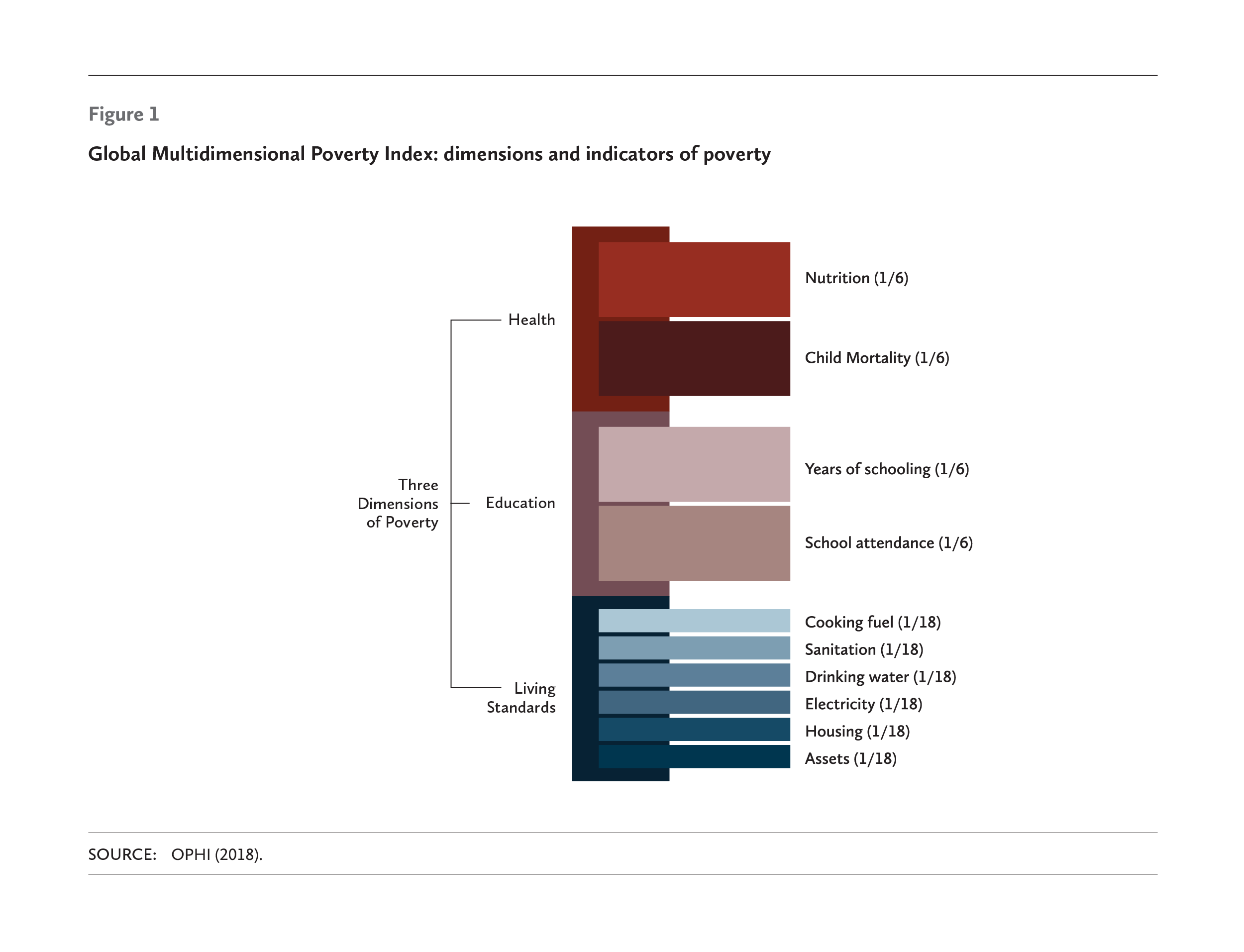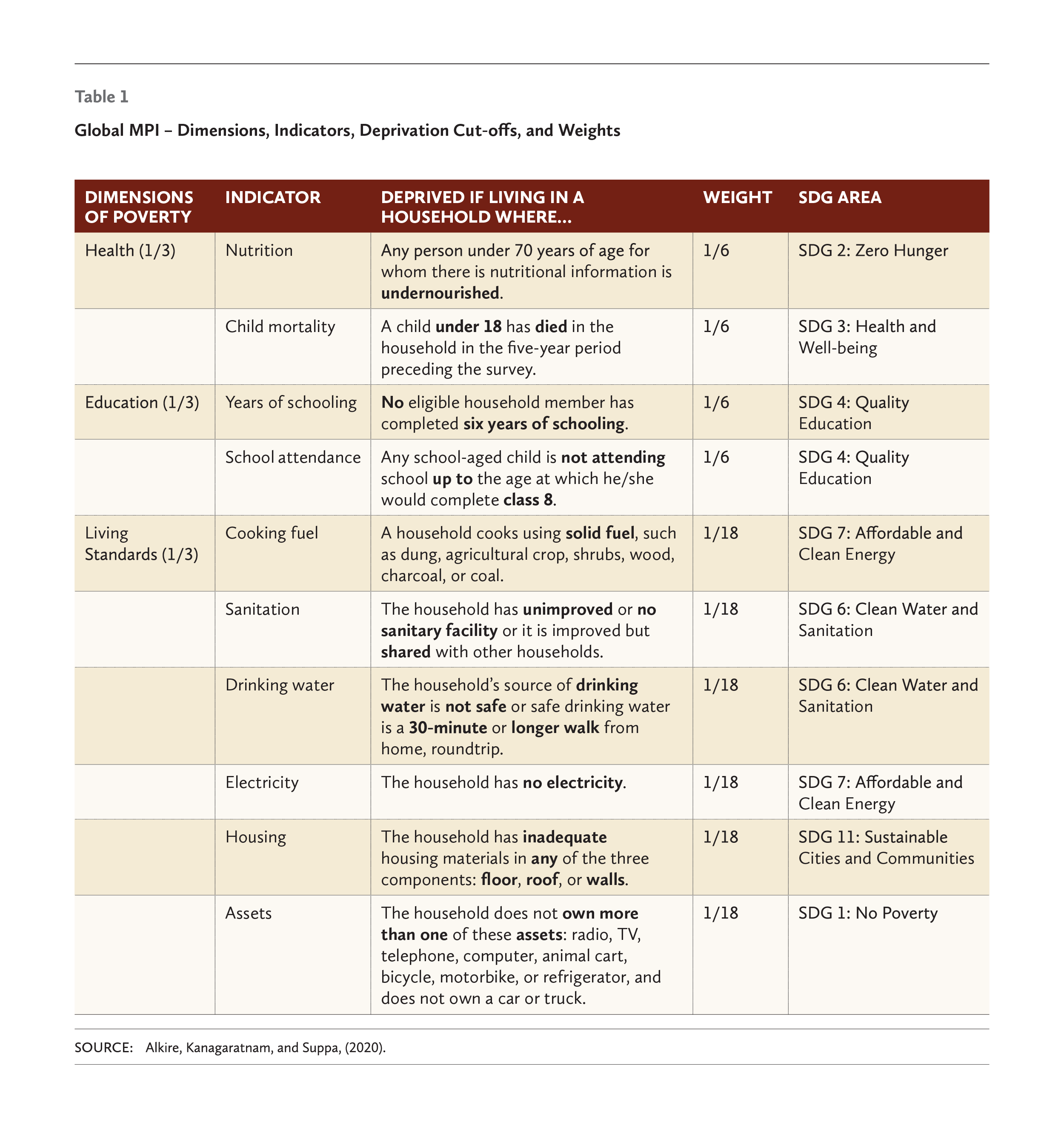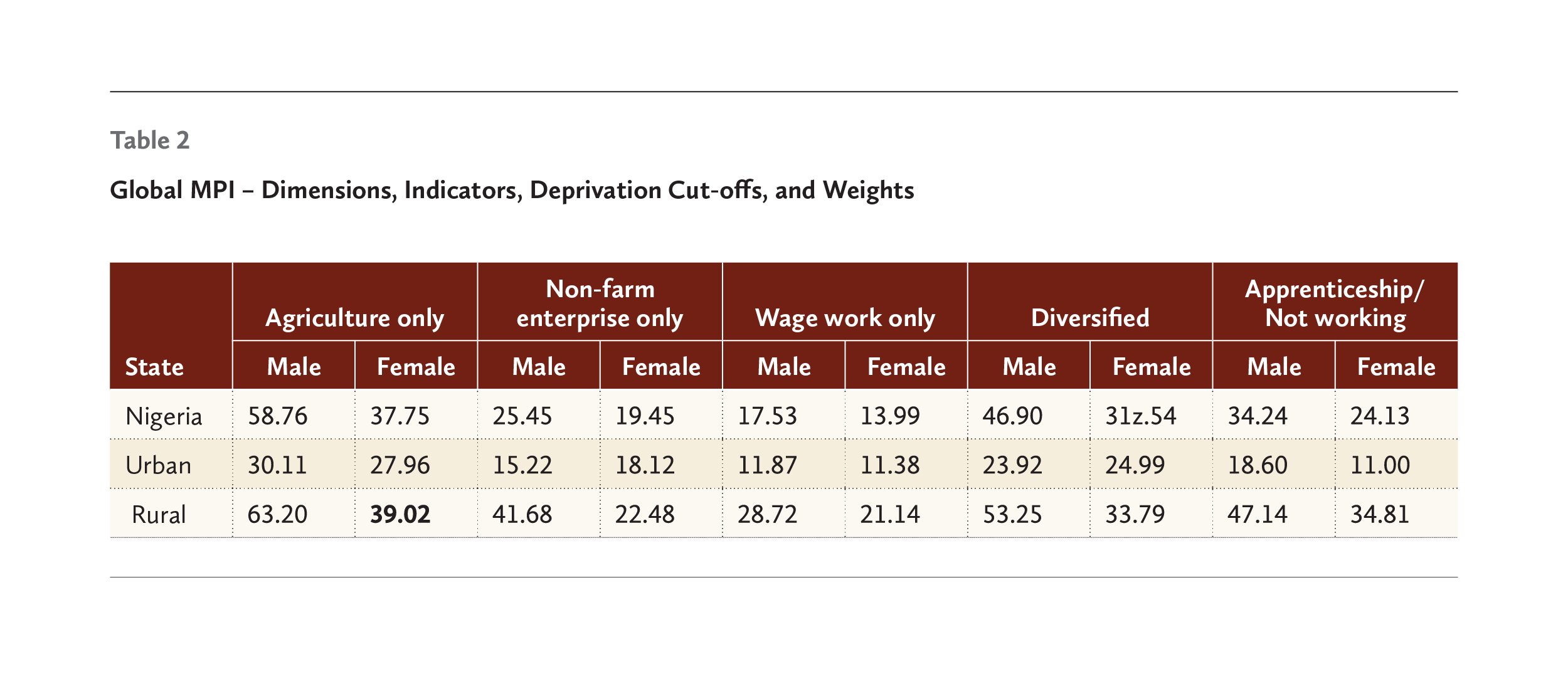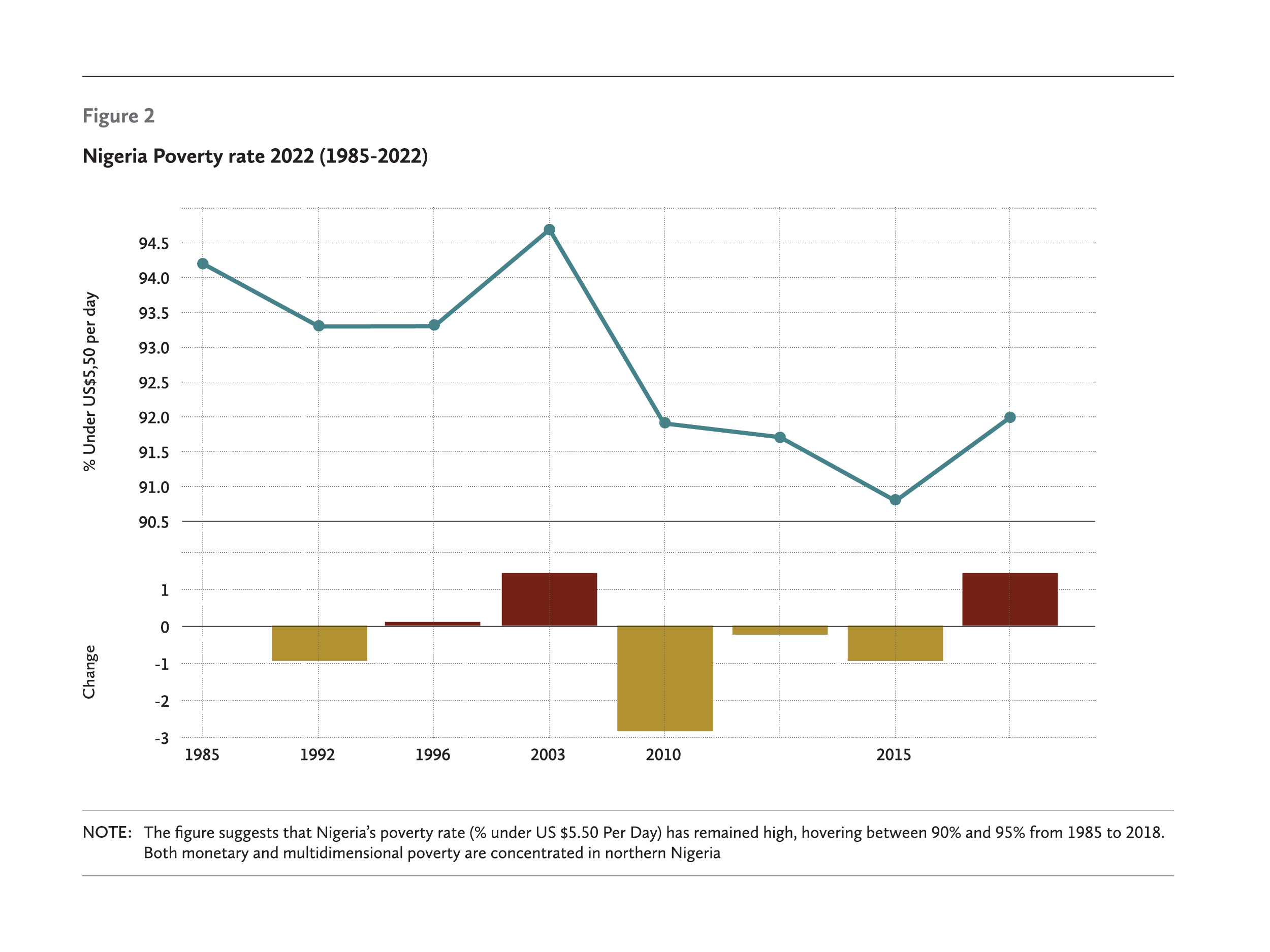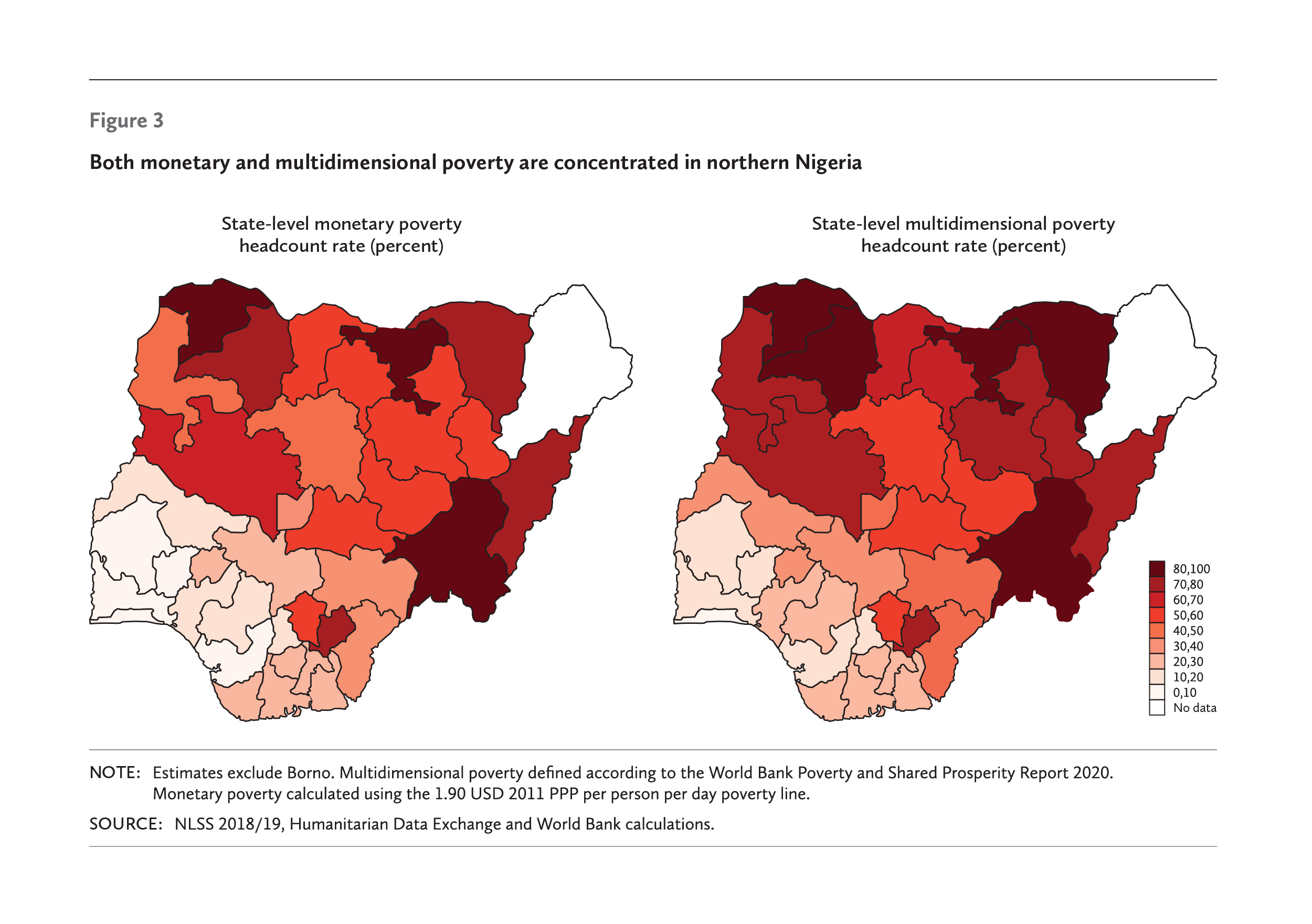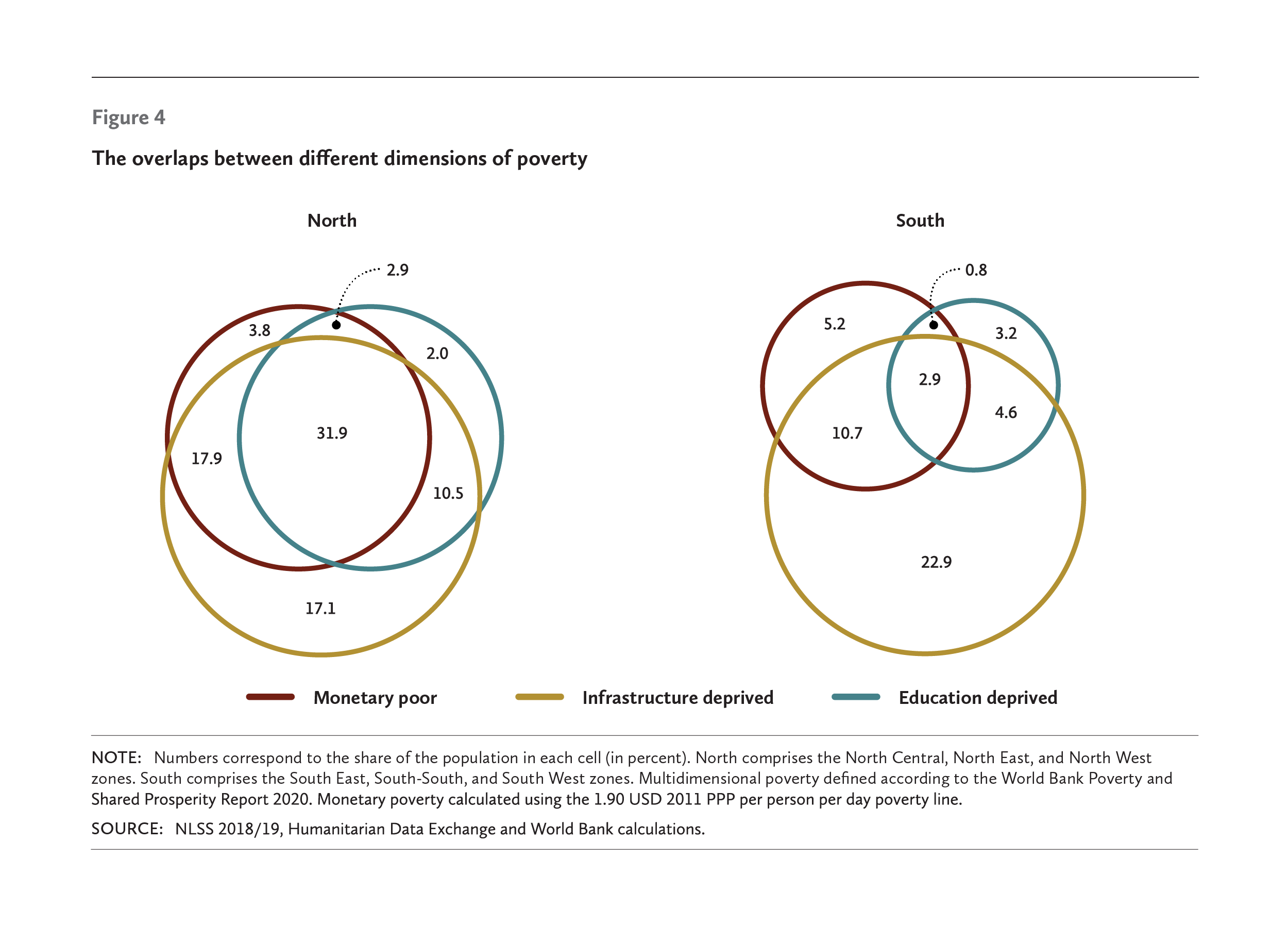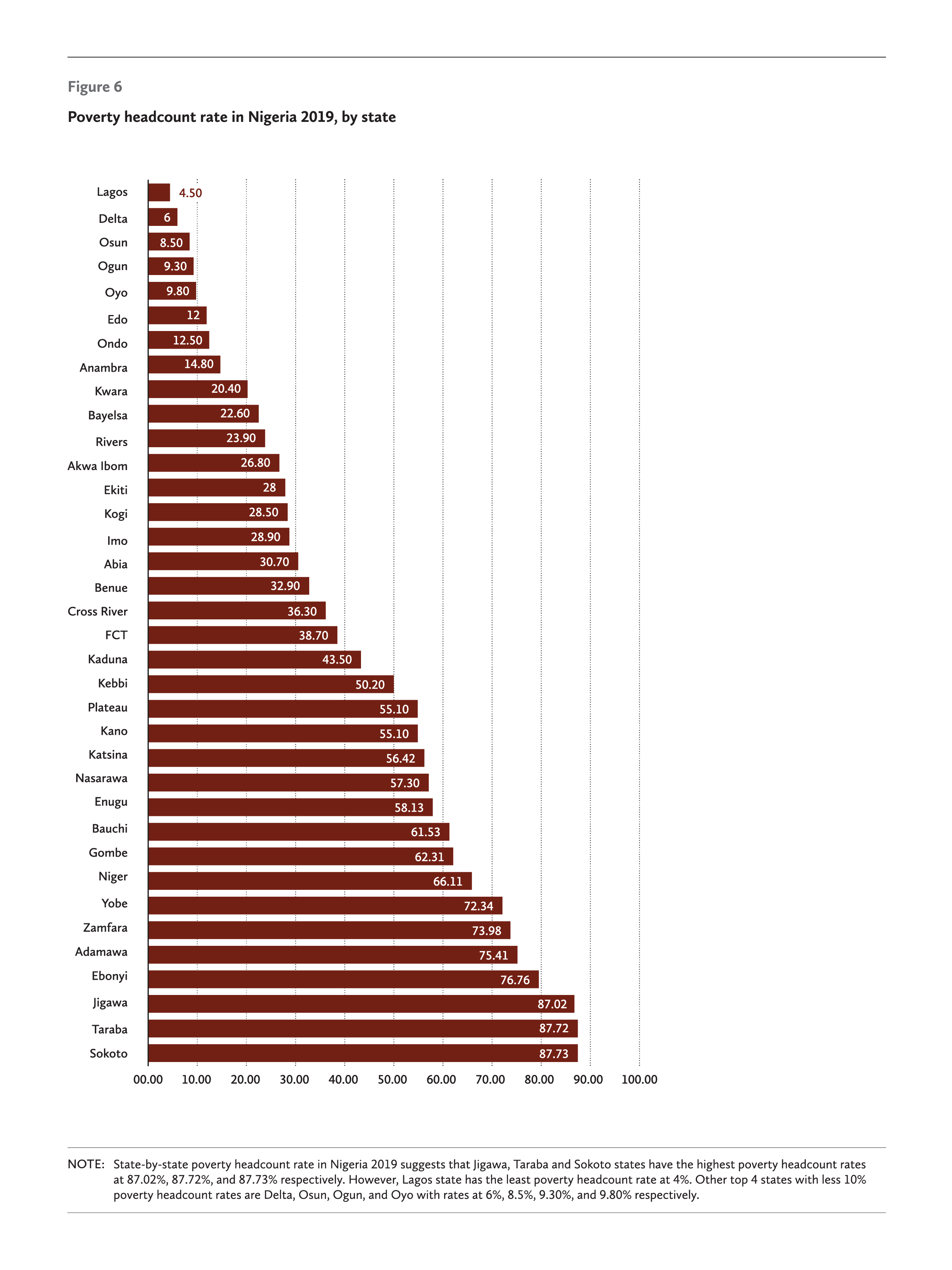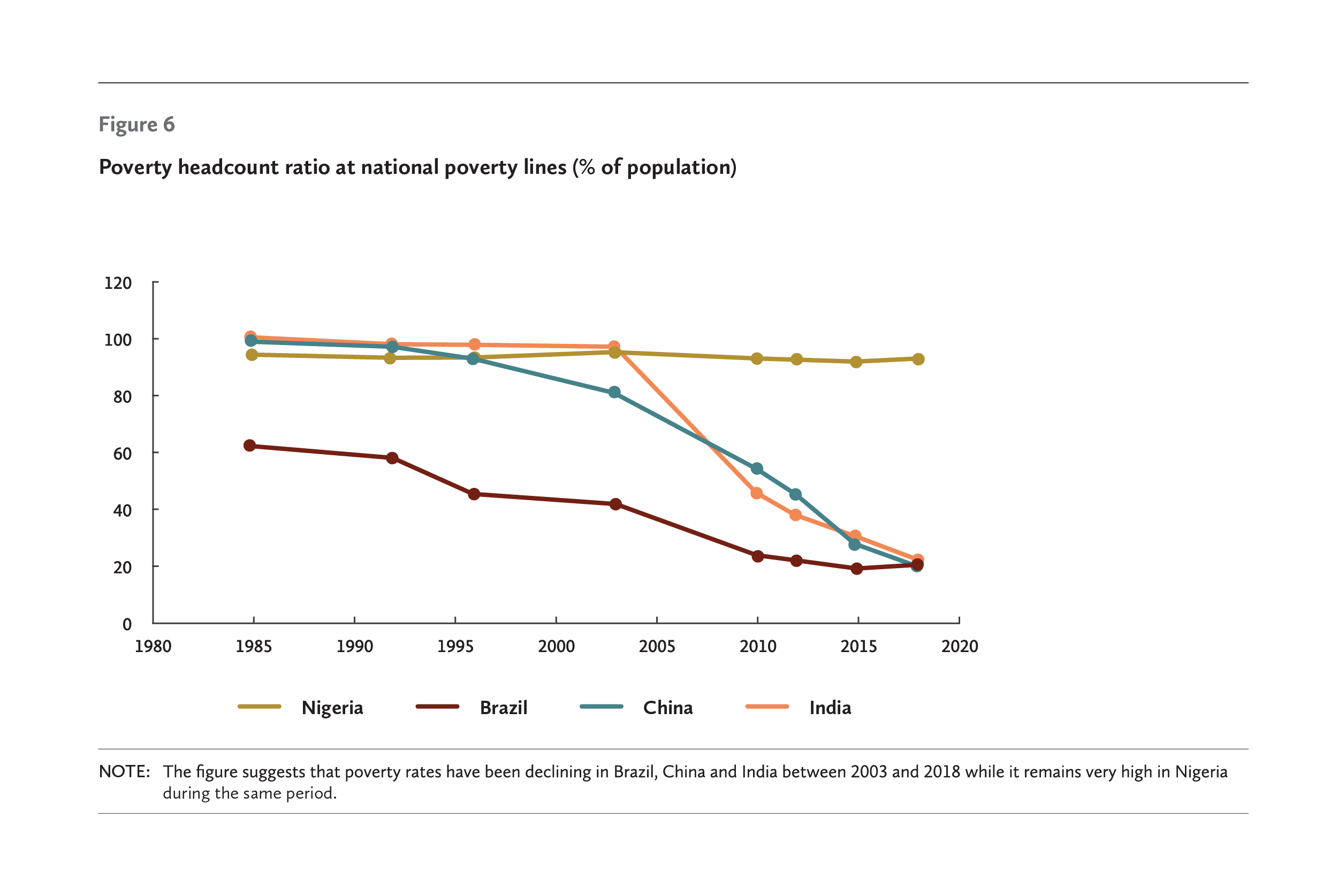1.0 EXECUTIVE SUMMARY
Poverty is difficult to define precisely, but we can clearly identify it when we see, hear, or experience it. Citizens of a nation who live in poverty suffer economic, cultural, social, political, and environmental deprivations. A lack of income is only one aspect of poverty. It also covers the several effects of this deficiency. The non-financial aspects of poverty include situations such as material squalor, impotence, social exclusion and powerlessness, a lack of opportunities, a lack of education, and sub-par living conditions.
Multidimensional poverty is the name given to this occurrence. Because monetary-based assessments ignore a lot that also matters, a multidimensional approach is required to measure poverty. Moreover, economic growth does not always result in a decline in poverty or deprivation. Furthermore, impoverished people frequently use multifaceted descriptions to convey their experiences of poverty.
People live in poverty for a variety of reasons such as inequality and marginalization, conflict, a lack of education and skills, a lack of employment or other means of support, high food prices that reduce their purchasing power, the effects of climate change such as floods and droughts, a lack of savings, inadequate social welfare and social security programs provided by the government, and unchecked population growth.
With a Gross Domestic Product (GDP) of $440 billion, Nigeria is the largest economy in Africa, but the country is caught in a deep poverty cycle.
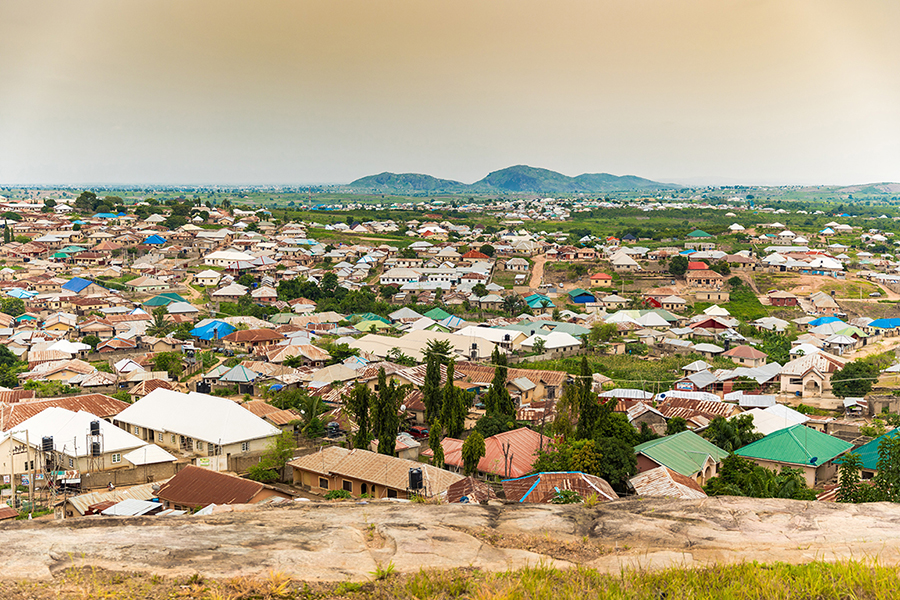
With a Gross Domestic Product (GDP) of $440 billion, Nigeria is the largest economy in Africa, but the country is caught in a deep poverty cycle. According to the World Bank, 95 million Nigerians will be considered extremely poor by 2022, up from the current national average of 89 million, or 43% of the population. This calculation is based on the extreme poverty mark of less than $2.15 a day. More than 90% of Nigerians live in poverty when compared to the $5.5 daily poverty limit.
Nigerians continue to live in poverty as a result of the effects of climate change and conflict, which have been made worse by the Covid-19 pandemic, as well as more fundamental causes like slow economic growth, low levels of human capital, unemployment, and exposure to global economic shocks resulting from a reliance on crude oil for foreign exchange earnings. Nigerian poverty is notable in particular because it has been escalating amid a sizable, expanding economy that has largely excluded a vast majority of the population.
Northern Nigeria continues to be the region with the highest concentration of poverty in Nigeria, whether assessed by a state’s multidimensional or monetary poverty headcount. In rural places, poverty is more pervasive. Furthermore, poverty is unevenly distributed throughout Nigeria even across particular geographic areas. This implies that for initiatives to reduce poverty to be successful, they must be precisely targeted.
More than 90% of Nigerians live in poverty when compared to the $5.5 daily poverty limit.
More than just economic factors have resulted in mass poverty in Nigeria. The country’s poverty trap was brought about by a failure of nationhood and governance. This is because the political elite has placed a considerably greater emphasis on self-serving state capture for patronage and sectarian interests than on a sincere desire to end poverty. A broken and corrupt political system has created the wrong priorities. As sectarian interests and the dominant partisan political reward system combine to supersede knowledge and competence in public policy, it has also steadily undermined state capacity and state institutions, encouraging knowledge gaps and incompetence in key decision-making positions.
Nigeria’s unchecked population growth in the midst of the current high poverty rates also contributes to the perpetuation of the poverty trap and makes it intergenerational in nature. If this tendency is not reversed, it will have detrimental effects on Nigeria’s future. “Gendered poverty” – poverty that is caused and maintained by gender-specific issues such gender inequality, discrimination, and exclusion – is a significant component of Nigeria’s poverty trap. These gender-specific aspects of poverty serve as a good illustration of multidimensional poverty.
At current trends, Nigeria will not be able to end extreme poverty for 35 million people by 2025, or for 100 million Nigerians within the next ten years, as indicated in its National Development Plan and other policy pronouncements by the government. The country requires a new elite development consensus on development that cuts through partisan political and other divides, as well as a unity of purpose that is focused on the human development of its 216 million citizens, in order to start making meaningful progress in the eradication of poverty. This agreement should be focused on creating a broadly prosperous society. Such an ambition would entail lifting millions of Nigerians out of poverty and moving them into the middle class through wealth creation.
Nigeria requires a new elite development consensus on development that cuts through partisan political and other divides, as well as a unity of purpose that is focused on the human development of its 216 million citizens, in order to start making meaningful progress in the eradication of poverty.
The forthcoming elections in February 2023 present a historic chance to start constructing this consensus across all facets of Nigerian society. Whoever wins the next presidential election and leads the next administration will be responsible for leading this historic effort. A key necessity for the achievement of this agenda is philosophical clarity regarding the roles of the state and the market in reducing poverty.
Other suggestions for eradicating poverty include, as a top priority, increased and carefully targeted investments in healthcare and education, creating an environment that encourages the creation of jobs in the private sector, bold fiscal reforms to increase government revenue through effective taxation and the elimination of wasteful fuel subsidies while mitigating the potential effects of subsidy removal on already poor citizens, and such other macroeconomic reforms as exchange rate adjustments.
Abolition of the Land Use Act, civil service and security reforms to improve state capacity and gender empowerment, intensified family planning education and services, and resolution of the conflicts (or “silent wars”) in various parts of Nigeria that have caused and exacerbated poverty through internal displacement and decreased food production are all structural changes necessary to enable millions of Nigerians to escape the poverty trap.
It is essential to make targeted investments to prevent or manage disasters brought on by climate change, such as floods and droughts. Along with revamping the micro-finance banking system and implementing hourly pay jobs, it remains crucial to use market-oriented mechanisms such as investing in venture capital funds run by the private sector to promote access to capital and job creation.
Poorly designed social protection measures, limited coverage, a lack of consistency, a lack of data, and corruption are some of the causes of inadequate social protection.
The social protection system in Nigeria is insufficient, ineffective, and therefore mainly ineffectual. In spite of several initiatives taken over the last 52 years by various administrations, poverty rates in Nigeria have remained high. Poorly designed social protection measures, limited coverage, a lack of consistency, a lack of data, and corruption are some of the causes of inadequate social protection.
Rethinking social protection remains necessary. Each administration that is voted to office implements its own plans that are mostly ad hoc, often discarding earlier plans by previous administrations. It is necessary to have a social protection system that is well-organized, expertly planned, and supported by national law.
Additionally, such a comprehensive social protection system needs to be independently and expertly examined, reviewed, and monitored to stop leaks caused by fraud and corruption. Implementing these measures while incorporating structural reforms will increase the chances of controlling the rise of poverty as a “growth industry” in the short term, while structural reforms will start to show results in the medium term.
We advocate the implementation of a social security program for Nigerians 65 and older. Nigerians in this age range number 5 million. These senior citizens could be effectively covered by guaranteed social security payments if the Federal Government of Nigeria were to successfully plug fiscal revenue leakages such as oil theft (estimated to cost $700 million per month or $8.4 billion per year) and direct misappropriation of public funds, combined with effective saving and management of a social security fund.
We believe Nigeria can set aside N5-7 trillion yearly to fund the operation of a thorough, well-managed social security system, as well as a comparable, separate allocation for education, healthcare, water, and sanitation. In order to save money in other areas of government, infrastructure projects should be financed mostly through public-private partnerships, with the exception of rural infrastructure. The cost of governance should be reduced.
Brazil and China both present significant case studies on the successful eradication and reduction of poverty. In the case of China, these achievements have been outstanding. China has assisted almost 800 million of its citizens to escape poverty over the past 40 years, contributing nearly 70% of the figures for the eradication of poverty worldwide.
In China, visionary political leadership helped to forge a national consensus in order to end poverty.
This trend was supported by philosophical clarity, pragmatism, and strong political and institutional capability throughout the past 50 years, which saw economic policy move away from socialism to market-driven incentives in the agricultural and industrial sectors. Strong social security policies have been a major factor in Brazil’s success in reducing poverty. Nigeria can and should carefully adopt ideas from both nations’ strategies and modify them for local circumstances.
2.0 INTRODUCTION
Poverty is a significant strategic threat to Nigeria’s future. An estimated 95 million Nigerians – nearly half of the country’s population – live in extreme poverty, with more at risk from deprivation and loss of purchasing power from inflation and a stressed macro-economy, and the country’s population is growing rapidly.
Why do countries exist? The authors of this paper contend that every State, including Nigeria, should make an effort to flourish by steadily enhancing its citizens’ level of life. A State in which many citizens struggle to make ends meet and are perpetually in “survival” mode is failing in its primary purpose. According to Article 14(2)(b) of the Federal Republic of Nigeria’s 1999 Constitution, “the security and welfare of the people shall be the primary purpose of government.” As it was for many other cultures that have succeeded in this endeavour to improve the lives of their residents, Nigeria faces a civilizational challenge in conquering poverty.
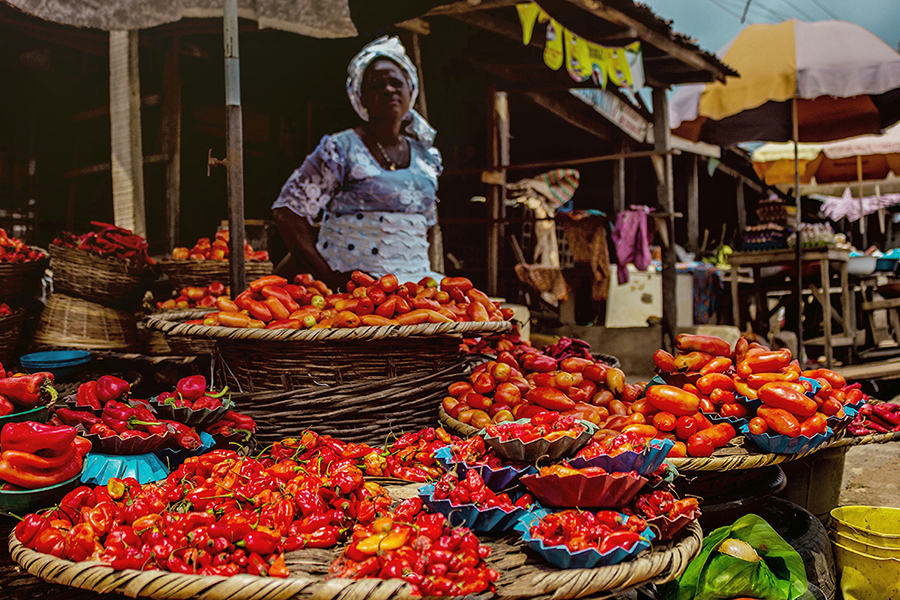
While poverty is a global issue, it has mostly affected Africa over the past four decades as a result of the Rising Asia phenomenon. This trend has seen much of East Asia and South Asia overcome low wages and sub-par living circumstances and move steadily toward widespread wealth. Nigeria is the most populous nation in Africa, making its high poverty rate all the more significant.
This policy paper includes potential policy options as well as a picture of the current status of poverty in Nigeria. It also highlights the primary causes of this condition.
The goal of the paper is to “understand” the Nigerian poverty trap, its dimensions, effects, and potential solutions while also offering directional policy recommendations. We have avoided a temptation to rush to “solutions” to what is actually a complex phenomenon based on popular thinking that: “Everyone knows that millions of Nigerians are poor; the question is: what can we do about it?” Without a clear knowledge of the meaning, nature, drivers and context of the poverty trap, it will be difficult for Nigeria, Africa’s most populous nation, to overcome this existential crisis.
Without a clear knowledge of the meaning, nature, drivers and context of the poverty trap, it will be difficult for Nigeria, Africa’s most populous nation, to overcome this existential crisis.
While poverty is fundamentally an economic situation, eradicating it requires more than just technical economic strategy; it also requires political organization and political will that is driven by a philosophical/psychological mind-set among leaders and individuals. Only a suitable mind-set or worldview–our perception of the world we live in and our place and purpose in it–may lead to competent economic policy and its efficient execution. Such a vision serves as a broadly shared catalyst for a competitive national goal and propels actual, quantifiable advancement.
The papers’ suggestions emphasize this political and political economy dimension as the essential framework for public policies that will actually free millions of Nigerians from the cycle of poverty. China’s transformation and it’s eradication of poverty was made possible primarily by the rise of leaders who are preoccupied with development. For instance, and of particular relevance to Nigeria, a society with poor rule of law and a lack of true accountability will have a difficult time eradicating poverty and attaining development because it lacks the necessary conditions for the emergence of a stable political order.
The absence of a genuine elite agreement on nationhood is a similar issue. This knowledge ought to encourage us to pursue structural reform to bring 100 million Nigerians out of poverty, as we attempt to in this paper, rather than quick-fix solutions that, in the end, have short shelf lives.
The study starts off by discussing what poverty means and how it is assessed. It then looks at why and how individuals become poor. It goes on to examine the poverty trap in Nigeria, along with its particular circumstances such as a crisis of unchecked population growth. The experience of Brazil and China in eradicating and reducing poverty is next briefly discussed.
We wrap up by revisiting our original policy thesis, which is that human development and economic transformation are, first and foremost, about political will and the organization of governance. Political leaders with a worldview dedicated to improving the human conditions of their compatriots – and have the capacity and competence to drive this process – are more likely to emerge if the environment and quality of Nigeria’s electoral contests for political power and representation improve.
3.0 WHAT IS POVERTY?
While most individuals are able to identify poverty when they see it, they frequently struggle to describe it in detail. Experts face the same challenge. Thus definitions typically take into account what is easiest to measure. Lack of resources to meet necessities like food, clothing, and housing constitutes poverty.
Another definition of poverty is when people or households lack the resources to support themselves or purchase the essentials for a fulfilling existence. This entails being so destitute that finding adequate food, clothing, shelter, and medical care is difficult. Poverty is both an individual issue and a larger communal issue. Making ends meet can result in a variety of physical and mental problems for an individual or family. High poverty rates can have a negative impact on society as a whole and are linked to issues like crime, unemployment, urban deterioration, lack of education, and bad health. Governments frequently design social welfare programs, as a result, to assist in rescuing families from poverty.
But poverty goes far beyond simply not having enough money. It is a political concept as well. While many policymakers believe that poverty cannot be justified and must be eradicated, others see poverty as an inevitable result of economic failure or even as a deserved recompense for personal irresponsibility. Politics often frames and fuels the discussion of poverty, and the need for policy change drives many studies. It can be challenging to examine poverty objectively because so many commonly held beliefs about the condition are hotly debated.
According to the World Bank, hunger is a defining characteristic of poverty. Absence of shelter is poverty. Being sick and unable to visit a doctor is poverty. Being illiterate and lacking access to education are both aspects of poverty. Lack of employment and day-to-day existence out of fear of the future are what constitute poverty.
According to the World Bank, hunger is a defining characteristic of poverty. Absence of shelter is poverty. Being sick and unable to visit a doctor is poverty. Being illiterate and lacking access to education are both aspects of poverty. Lack of employment and day-to-day existence out of fear of the future are what constitute poverty. Poverty has been characterized in a variety of ways and takes on several forms that vary from place to place and over time. Most of the time, people desire to get out of poverty. Poverty, then, is a call to action for both the wealthy and the poor, a call to change the world so that more people may have access to food, shelter, education, and healthcare, as well as protection from violence and a voice in their community affairs.
An individual is deemed to be living in poverty if their income falls below the international poverty level. It is computed by taking the poverty line for each nation, multiplying it by the cost of the items required to support one adult, and then converting the result to US dollars. The World Bank raised the previous worldwide poverty limit from $1.90 to $2.15 per day in September 2022. This is the definition of extreme poverty, which differs from the conventional definition of poverty as having an income of less than $5.50 per day. Many people around the world continue to experience financial hardship as measured against this standard of extreme poverty. In 2021, the Bank estimated that 711 million people were living in extreme poverty. This indicates that approximately 10% of people worldwide are considered to be impoverished.
In addition to a lack of money, poverty also refers to the inability to engage in leisure activities. For example, not having enough money to send children on a field trip with their classmates or to a birthday party, or to purchase medicine for an illness. These are all expenses related to poverty. People who are barely able to cover their basic needs such as food and shelter are simply unable to factor in these additional costs.
Sustainable Development Goal (SDG) 1, “No Poverty” calls for the eradication of poverty in all of its manifestations worldwide. However, poverty is more than just a lack of resources such as money or resources equivalent to money that are needed to meet basic necessities. People who live in poverty also simultaneously deal with the numerous effects of this lack. Some of these negative effects—the non-financial aspects of poverty—serve to prolong poverty and may even contribute to its continuation.
This concept of “multidimensional poverty” encompasses a wide range of traits including scarcity of resources, material squalor, social marginalization, helplessness, and physical and mental illness. Combining these scores on the various categories could result in numerous forms of poverty, each with a different level of severity on prospects for the future (e.g., income low but asset rich; physically fit but financially stressed).
The various aspects of poverty, however, cannot be measured by a single index. Poor health, inadequate living standards, a lack of education, lack of power, low-quality work, the threat of violence, and living in environmentally dangerous locations, such as the Nigerian oil-producing Niger Delta, are just a few of the numerous deprivations that poor people face on a daily basis.
To help guide policies aimed at lowering poverty and deprivation in a country, a multidimensional measure of poverty can be used to include a variety of indicators that capture the complexity of this problem. Different indicators can be chosen to reflect the requirements and priorities of a country as well as its constituent regions, districts, provinces, etc., depending on the context of a country and the aim of the measure. The Multidimensional Poverty Measure (MPM), which incorporates access to education and basic infrastructure along with the monetary headcount ratio [to produce a] $2.15 international poverty line, aims to understand poverty beyond the financial deprivations which continue to be the focus of the World Bank’s monitoring of global poverty.
An international indicator of severe multidimensional poverty that includes over 100 developing nations is the global Multidimensional Poverty Index (MPI). By reflecting the acute deprivations in health, education, and living standards that a person confronts concurrently, it complements conventional monetary poverty measurements. The MPI measures poverty on a personal level. A person is classified as “MPI poor” by the global MPI if they lack three or more of the ten (weighted) markers. The percentage of deprivations they are facing can also be used to gauge how severe or extensive their poverty is.
Why use a multidimensional approach?
- Money-based assessments of poverty often fall short. According to studies, there is some overlap between monetary and non-monetary indices of poverty. Most of the time, not everyone who is multi-dimensionally poor is also income poor, and not everyone who is income poor is also multi-dimensionally poor. To more accurately inform the policies meant to alleviate the demands and plights encountered by poor populations, both monetary and non-monetary indicators of poverty are required.
- Growth in the economy does not always mean less poverty or hardship. Numerous studies have discovered that a decline in other deprived conditions, e.g. child hunger or child mortality, is not closely correlated with economic progress.
- People who live in poverty describe it as having multiple dimensions. Participatory exercises show that poor people’s definitions of unhappiness cover a wide range of issues, including poor nutrition, inadequate sanitation and clean water, social exclusion, low education, sub-par housing circumstances, violence, shame, and dis-empowerment.
- The more information about poverty that is pertinent to policy attention is available, the better equipped policymakers will be to combat it. For instance, a different approach to reducing poverty is needed for impaired living conditions versus deprived educational opportunities.
The numbers suggest that the poverty headcount rate, calculated by the kind of work a household head does to earn money, is highest both for a male and females whose income-generating activity is agriculture only and least for household heads whose income-generating activity is wage work only.
Growth in the economy does not always mean less poverty or hardship. Numerous studies have discovered that a decline in other deprived conditions, e.g. child hunger or child mortality, is not closely correlated with economic progress.
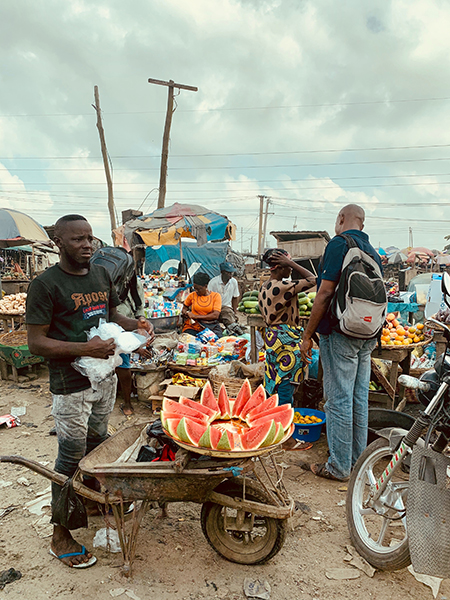
4.0 WHY ARE PEOPLE POOR?
- Inequality and Marginalisation
The institutional hurdles that prevent some groups of people from having access to opportunities, a voice, or representation in their communities are often referred to as “inequality”. This label, however, can be deceptive. All groups must have access to opportunities and be active in decision-making for a population to escape poverty, especially when it comes to having a say in matters that determine their status in society. Some of these opportunities might be plain to see, while in other cases they might be more subtle. - Warfare/Conflict
One of the most prevalent types of risk causing poverty today is conflict. As we have witnessed in several theatres of conflict, widespread, ongoing violence may bring civilization to a standstill, devastate infrastructure, and force people to leave their dwellings (often with nothing but the clothes on their backs). Syria’s middle class has virtually disappeared ten years into the conflict in that country, and more than 80% of the population now lives below the poverty line. - Little or no Access to Clean Water, Sanitation, and Hygiene
At present, more than 2 billion people in the world live without access to safe water. This has created a reality in which people travel great distances to acquire water for an estimated 200 million hours each day. That is valuable time that could be spent working or studying to improve one’s chances of finding employment in the future. A variety of waterborne diseases, from the chronic to the life-threatening, can also be brought on by contaminated water. Poor sanitation and hygiene facilities, as well as inadequate water infrastructure, can exacerbate this or create other obstacles to overcoming poverty, such as keeping females out of school during their menstrual cycles. - Climate Change
Climate change contributes to the cycle of poverty in various ways, including by disproportionately harming women, producing refugees, and even inciting violence. It causes hunger by either too little (drought) or too much (flooding) water. According to a World Bank report, nearly 100 million people could fall into poverty over the next ten years as a result of climate change. - Lack of Education and Skills
Not all people without a formal education are in dire straits. However, the vast majority of the very poor lack formal schooling. Around the world, there are various obstacles to education, such as a lack of funding for uniforms and textbooks, prejudice against girls’ education, or many other factors. But since it may open the door to jobs and other opportunities and resources that a family needs to not only survive, but also to prosper, education is frequently referred to as the great equalizer. According to UNESCO, 171 million people may be rescued from extreme poverty if they graduated from high school with rudimentary reading abilities. Education is threatened by poverty, yet education can also fight poverty. - Poor Public Works and Infrastructure
Imagine that there are no roads leading to the place where you need to get to work. Or perhaps your path has become impassable due to recent severe rainfall. Rural towns may become isolated due to a lack of infrastructure, which includes roads, bridges, and wells as well as cables for light, cell phones, and the internet. Living off the grid frequently entails being unable to travel to work, school, or the market to acquire and sell items. In addition to taking more time and money, traveling farther to receive basic services keeps families in poverty. Opportunity is limited by isolation. Many people find it difficult, if not impossible, to transcend extreme poverty without opportunity.
- Lack of Government SupportIn order to prevent extreme poverty, social welfare and security support are crucial. However, not every government is able to offer their citizens this kind of assistance. Without that safety net, there is nothing to prevent vulnerable families from sinking even further into extreme poverty.
- Lack of Jobs or Livelihoods
It may seem obvious that people will experience poverty if they don’t have a work or a means of subsistence. Many traditional livelihoods are under increasing strain due to the lack of access to productive land, which is frequently caused by conflict, population growth, or climate change, as well as the overexploitation of resources such as fish and minerals, which could push people into abject poverty.
- Lack of Reserves
If a family or community has reserves in place, they can withstand any of the aforementioned risk factors, such as conflict, climate change, or a lack of government support. Unemployment caused by a war or illness can be compensated for by cash reserves and loans. If a drought or other natural calamity destroys a harvest, proper food storage techniques can be helpful. Extremely poor people frequently lack access to these resources. This means that when a risk materializes as a catastrophe, people resort to unhealthy coping strategies, such as removing kids from school to work (or even get married) and selling off assets to pay for food.
- High Food PricesThe World Bank has stated that a 22% increase in food prices is one cause for the seven million Nigerians who have been pushed into poverty in Nigeria. About 60% of Nigeria’s 21.09 inflation rate can be attributed to food prices. Rising food costs make poverty worse by lowering households’ real purchasing power and diverting money from necessities like housing, health care, and education. An average Nigerian household spends 56 percent of its income on food – the highest such rate in the world Food spending rates in the US, UK, Canada, and Australia are 6.4%, 8.2%, 9.1%, and 9.8% respectively. A minor increase in food costs would likely cause more individuals in Nigeria to fall into multidimensional poverty, given the country’s high food spending
- PopulationUnchecked population expansion can play a significant role in the spread of poverty. In the first place, it can slow the growth of per capita income ( income per person), which worsens poverty as more individuals look for ever-more elusive ways to escape it and fiscally strapped states struggle to support huge populations. Second, unchecked population expansion puts pressure on the availability of land in countries with limited space and high population densities, leading to landlessness and ultimately poverty.Third, rapid population growth has a negative impact on children’s health since having more children tends to make healthcare more expensive for those living in low-income homes. It affects the education of children in families that are already struggling financially by encouraging trade-offs that increase poverty, such as child labour and early marriage for girls, because impoverished parents will not have as much money to support many children in school. This is a pathway for transferring material poverty into other types of poverty, which perpetuates poverty across future generations.Fourth, the labour market might exacerbate poverty as a result of rapid population growth. When there are too many job seekers, especially for low-skilled positions, companies frequently underpay employees since there is a surplus of labour available. This also occurs in nations whose economies are fuelled by “intensive” growth based on conventional production variables like labour and land. The situation is different in nations that have already established themselves as “knowledge societies,” where productivity is driven by technical innovation, skill, and broad-based economic growth. In general, high population expansion increases unemployment, as evidenced by the 55% youth unemployment rate in Nigeria.
About 60% of Nigeria's 21.09 inflation rate can be attributed to food prices. Rising food costs make poverty worse by lowering households' real purchasing power and diverting money from necessities...
5.0 NIGERIA'S POVERTY TRAP
Nationally, 89 million Nigerians (43%) live below the poverty line, while 53 million (25%) are considered vulnerable (World Bank, 2022). The World Bank predicts that 95.1 million Nigerians will be living in poverty by 2022.
According to the Bank, the COVID-19 pandemic has increased Nigeria’s rate of poverty, which will result in an additional 5 million people living in poverty by 2022. Over the course of more than a decade, from the early 2000s to 2014, poverty in Nigeria increased in contrast to the country’s robust economic growth. Nigeria had one of the fastest growing economies in the world in the 2000s with annual economic growth averaging over 7%. In Nigeria, however, the number of the poor climbed from 69 million in 2004 to 112 million in 2010, or 69 percent of the population. The number of millionaires climbed by almost 44% in that period.
In 2022, 4 in 10 Nigerians, according to the World Bank, were considered to be living in poverty. In Nigeria, poverty was defined as earning less than 137.4 thousand Nigerian Naira (about 361 USD) annually. One of the most crucial lessons to be learned from this occurrence is that although economic growth and human development are related, human development—which is motivated by freedom and the ability to meet basic needs—is distinct from economic growth. However, as we contend, human development remains the most appropriate foundation for a nation’s advancement. Without this necessary foundation and without achieving structural transformation, economic growth as measured by GDP statistics may be an illusion.
According to the World Bank research, Nigeria’s poverty is a result of slow growth, a lack of human capital, flaws in the labour market, and exposure to shocks. Many Nigerians also lack access to essential facilities like power, clean drinking water, and adequate sanitation, particularly in the northern part of the country.
The report also points out that because the majority of employees are employed in modest domestic farm and non-farm businesses, their labour is not translating into jobs that will enable Nigerians to escape poverty. Only 17% of Nigerian workers are employed in the wage positions that can most effectively help individuals escape poverty.
According to the paper, the COVID-19 epidemic has made climate and conflict shocks, which disproportionately affect Nigeria’s poor, worse. However, the government has fallen short of helping households significantly. Families have started using risky coping mechanisms, such cutting back on their education and food intake, which could harm their human capital in the long run. Some regions of Nigeria are more affected by these problems than others. Foreign Direct Investment (FDI), competition, and job creation—all necessary for broad-based (inclusive) growth—have also been constrained in Nigeria due to the country’s inconsistent foreign exchange rates for various types of transactions and trade restrictions, such as bans on some goods and the 2019 border closure. These factors have decreased investors’ confidence.
Within-Country Differences
Because monetary and multidimensional poverty are unequally distributed throughout different geographic areas in Nigeria, poverty reduction efforts must be properly targeted. The northern states of Nigeria are generally where you will find both monetary and multifaceted poverty. Additionally, it does not appear that the infrastructure and educational divide between the north and south has narrowed over time.
In Nigeria, multidimensional poverty outpaces monetary poverty by a large margin, as is the case globally. In the north, 16.0 percent of individuals who are multi-dimensionally poor and 21.4 percent in the south are not considered to be monetarily poor.
A Multidimensional Poverty Index study carried out by the National Bureau of Statistics (NBS) and published in November 2022 revealed, unsurprisingly, that 133 million Nigerians, or 63% of the country’s population, were multidimensionally poor. The study found that 86 million of these multidimensionally poor Nigerians, or 65%, live in Northern Nigeria while 47 million or 35% live in Southern Nigeria. The findings confirm that poverty is a predominantly rural phenomenon, with 72% of people in rural areas found to be poor compared to 42% in urban areas. More than half of Nigeria’s population are so poor that they cook with dung, wood and charcoal instead of cleaner energy sources.
Weak Nationhood and Governance
The absence of effective nationhood and governance is the main factor contributing to Nigeria’s poverty trap. This generalized term is used in this research to define a number of the characteristics of the Nigerian State. These include the political leadership elite’s lack of genuine devotion to the State and its population, a capture of the State by special interests, the political elite’s extreme corruption, and the lack of a wide elite agreement on development as a top priority of public administration.
Others include weak state capacity (the ability to defend territory from external challenges such as terrorism, the ability to mobilize fiscal revenues from taxation and other sources, and the ability to deliver administrative and social services), knowledge gaps regarding the implications of economic policy decisions, dependence on natural resources (in this case crude oil) for revenues, and systemic shocks from international commodity prices. Many evaluations, especially more technical ones like those by international organizations and academic economists, fail to give this component of the poverty trap enough attention.
Nigeria still has not established a shared sense of values, purpose, or destiny. In other words, a transition from country to nation has not yet been achieved: Nigeria still lacks a common national perspective that could motivate real goals for the structural reform of the economy and the human development of its more than 200 million citizens. Because of this, improving the quality of life for the populace is rarely the primary goal of the struggle for political power. While the vocabulary of politics and electoral campaigns undoubtedly reflects this presumptive goal, the reality in terms of governance achievements has frequently been different. Conversely, there is frequently a shared desire among leaders and people in economically prosperous nations to better individual living conditions and achieve national prosperity. Election campaigns are then waged on ideological stances on how best to accomplish that common objective.
In Nigeria, electoral politics has long served the exclusive interests of class, ethnic, and religious identities looking to claim state resources and other advantages over other groups. Only a small percentage of these riches are redistributed. When they are, it happens via patronage networks or in the context of small-scale, individual philanthropy rather than on the basis of an objective exercise that would benefit millions of people who are poor or at risk of becoming so.
Furthermore, there appears to be little reason for the political elite to desire millions of poor Nigerians – and potential voters – to escape the poverty trap given the nature of electoral politics, in which poverty and the vote-buying the condition enables can confer electoral advantages.
These elements—far more so than technical or economic ones—prevent the creation of a setting that is supportive of good governance and can result in positive development results. One essential element of such an atmosphere is the evolution of electoral politics with a human development-oriented goal, one based on policy concerns, performance evaluation, and a singular concentration on pulling millions of Nigerians out of poverty. The effective rule of law and accountability is a requirement for the emergence of such an environment.
It is against this backdrop that the Federal Government of Nigeria has created the Nigeria Development Plan (NDP) 2021–2025, which aims to create 21 million new full-time jobs by 2025 and contains a declared objective to lift 35 million Nigerians out of poverty. The plan was created in collaboration with the public and commercial sectors as an extension of the prior Economic Recovery and Growth Plan (2017-2020).
More than 60% of the poorest people in Nigeria are women.
Gender Dimension of Poverty in Nigeria
More than 60% of the poorest people in Nigeria are women. Nigeria’s development has been negatively impacted by the gender component of poverty, which is especially severe in the country’s rural areas. Nigerian women, both in the rural and urban areas, are extremely underprivileged in practically every area of the economy, including politics, education, food security, and health. In all six of Nigeria’s geopolitical zones, women in families headed by women continue to experience high rates of poverty and hunger. These rates range from about 46.9 percent in the southwest to 74.3 percent in the northwest and northeast.
The key mechanisms through which the gender dimension of Nigeria’s poverty trap operates are gender inequality and discrimination. Pseudo-religious or cultural traditions, unequal educational possibilities, and a lack of equitable access to political leadership chances—particularly elective roles—are all contributing factors.
The effects of wars, such as the loss of farmland and limitations on farming prospects due to safety precautions, rape, kidnapping, and other abuses, also make gendered poverty worse. These elements have been particularly pronounced in the nation’s northeast, where the Boko Haram insurgency has claimed thousands of lives despite efforts by the Federal Government of Nigeria, the Nigerian Armed Forces, and non-governmental organizations (NGOs) to bring about a return to normalcy in the region. The effects of gendered poverty include an increase in social vices like formal and informal sex work and vulnerability to sexual exploitation, low self-esteem, vulnerability to exploitation and abuse by religious clerics, and low self-esteem because many women in Nigeria tend to turn to religion as a way to cope with poverty. Poor multitasking women frequently experience health problems as a result of their poverty.
The poor decisions that poverty forces on women, such as their children’s lack of access to school and skills, frequently perpetuate intergenerational poverty. In addition, there has been a rise in the number of homes led by women as male workers get entrenched or receive lower pay in a struggling national economy.
Population Dynamics and Nigeria’s Poverty Trap
Nigeria’s poverty trap is supported by the nation’s rapidly expanding population. Of Nigeria’s 216 million people, 70% are persons under 30 years old. The population of Nigeria is growing at a pace of 3.2%, while the GDP grew at a rate of 3.65% in 2021, 1.79% in 2020, 2.21% in 2019, 1.92% in 2018, and 0.8% in 2017. While GDP growth rates were much higher between 2000 and 2014, poverty rates increased significantly even during the years of high economic growth.
This raises the threat of increased poverty in Nigeria if population growth is not reined in. The country will become the third most populated in the world when its population reaches 263 million in 2030 and 400 million in 2050. Additionally, it has been predicted that Nigeria will house the greatest numbers of extremely poor people in the world by 2030. One-third of all individuals who are extremely poor worldwide in 2030 will live in Nigeria and the Democratic Republic of the Congo (DRC). The combined population of the two countries’ most vulnerable citizens will increase from 158 million to 178 million. According to estimates, Nigeria and the DRC would be home to 40% of the world’s poorest population by the year 2050.
When we take into account the relative youth of the country’s population profile and the number of young children of school age who are not in school, these estimates have significant consequences for social stability in Nigeria. At 20 million children according to UNICEF, this is the highest number of out-of-school children in the world. Because poverty is a result of lowered purchasing power, the projections also can have an impact on the viability of private sector businesses that would be striving to increase their profits.
A poverty-fragility trap has also been produced by the association between population growth and rising fragility in the Sahel region of West Africa. According to the International Labour Organization (ILO), fragile states are characterized by poor economic and social performance as a result of traits like bad governance, inadequate administrative capacity, ongoing humanitarian crises, ingrained social unrest, violence, or the aftereffects of war or armed conflict. Nigeria is plagued by all of these issues and was classified as the 16th most fragile state in the world by the Fund for Peace’s Fragile States Index in 2022.
In Nigeria, population is a contentious subject. This is due to the fact that it is primarily seen from a political and diplomatic perspective rather than an economic one. This perspective takes into account the implications for how domestic political influence will be distributed among the country’s regions as well as the “demographic power” that a large population will give Nigeria in international affairs. Many people think that Nigeria’s vast population, if appropriately tapped in terms of economic production, might be an asset even in the current setting. The United Nations Population Fund defines a “demographic dividend” as “the economic growth potential that might arise from variations in a population’s age structure, particularly when the share of the working-age population is bigger than the non-working-age share of the population.”
But this perspective presupposes that the working-age population is actually engaged in work. That is not the case in Nigeria. A social crisis of enormous proportions has therefore developed in the country as a result of the overwhelming reality of galloping population growth, poverty and its effects, the high level of unemployment (33% ), and the high young unemployment rate of more than 50%. A demographic time-bomb known as the “youth bulge,” in which a young population that is expanding quickly and has few skills and jobs would, out of frustration, be prone to social vices, criminality, and membership of terrorist groups, is already in progress.
To ensure that economic growth catches up with and surpasses population growth, caution and population management are still required. Nigeria remains susceptible to more conflict as a result of disputes between groups over ownership of land and the aggravation and maintenance of intergenerational poverty. Even with possible local modifications in the case of Nigeria, the experience of China, which shows how the Asian nation sacrificed population growth to achieve economic transformation, offers pertinent lessons.
A demographic time-bomb known as the "youth bulge," in which a young population that is expanding quickly and has few skills and jobs would, out of frustration, be prone to social vices, criminality, and membership of terrorist groups, is already in progress.
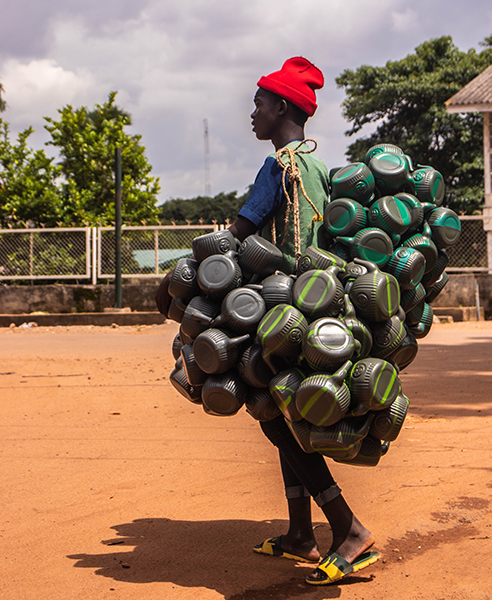
The Conflict, Inflation and Minimum Wage Cocktail
In Nigeria, the combined effect of conflicts in the Northeast region arising from attacks by Boko Haram/Islamic State West Africa Province, banditry in the Northwest, and from violent land grabs by killer herdsmen attacking farming and other communities in the North-central region, is to make farming and other agricultural communities unsafe and to discourage food production. This reality creates food inflation as these regions are all part of Nigeria’s food basket. Nigeria’s inflation rate was 21.09 in October 2022.
Meanwhile, the country has a low minimum wage of N30000 per month. This is still below international standards of extreme poverty. It also is below an average actual monthly cost of living estimated at N40000 per month for an individual and N137000 for a family. Combined with the phenomenon of wage stagnation, in which the wages of workers are not increasing because the cost of production is rising for many employers, and the value of what workers do earn is being undermined by inflation, and we have a deadly cocktail of poverty.
Social Protection Interventions in Nigeria
Nigeria lacks a social security system that is fully institutionalized and provides benefits for food assistance, welfare, children’s welfare, old age protection, and unemployment. A Revised Draft National Social Protection Policy published by the Federal Ministry of Budget and National Planning was published in 2018, and a National Social Safety-Nets Coordination Office was established in 2016. The administration of President Muhammadu Buhari has demonstrated ambition in the area of social protection, and there are several programs in existence, but just 2% of households and 4% of the poor in Nigeria have access to them, according to the World Bank in 2019.
Strong social protection is a hallmark of all nations with sound governance and is crucial to the fight against poverty. Therefore, one of the main responsibilities of Nigerian governance is to improve the country’s social protection programs. The Federal Republic of Nigeria’s Constitution, which states that the security and wellbeing of its population is the fundamental goal of government, supports this goal.
The major goals of social protection, according to the African Development Bank (AfDB), are to lessen poverty, economic shocks, and vulnerability. This in turn helps to set the specifications for the design of social protection for each individual country.
Federal, state, and local governments are the three levels of government in Nigeria. Prior to the current political system, both military and civilian governments had implemented several types of social protection programs at the federal level.
Examples comprised:
- Family Economic
- Advancement Programme
Better Life for Rural Women - Directorate for Food, Roads and Rural Infrastructure
- National Directorate of Employment
- Family Support Programme
Some of the core challenges that have impeded the delivery of social protection schemes in Nigeria include:
- Policy inconsistency
- Lack of funding
- Low coverage
- Poorly designed social protection schemes
- Corruption
- Lack of accountability
- Issues of targeting
- Lack of data indicating who are the poor
Committed efforts are required from all stakeholders in delivering sound social protection programmes to beneficiaries and overcoming these challenges. In order for current and future social protection programmes in Nigeria to have a significant impact on beneficiaries, some factors need to be taken into consideration. They include:
- Capacity assessment
- Increased funding
- Legislation on social protection
- Information management
- Stakeholder analysis
- Programme linkages
- Accurate and effective targeting
- Monitoring and evaluation
Consistency and sustainability
It is when these factors are taken into consideration that social protection programmes can effectively meet their aims and objectives to improve and protect the lives of beneficiaries. In sum, social protection programmes can indeed have a positive impact, as is highlighted in emerging evidence, if they are effectively designed, monitored, and funded.
The Better Life for Rural Women Programme is one of the few older-generation initiatives still in operation
Assessing Poverty Alleviation Programmes in Nigeria
Earlier policies and programmes directed at alleviating poverty by different regimes have not made a desired, sustained impact for several reasons. For instance, while General Yakubu Gowon’s Accelerated Food Production Programme (AFPP), President Goodluck Jonathan’s Subsidy Reinvestment Programme (SURE-P), Olusegun Obasanjo’s Operation Feed the Nation (OFN), Shehu Shagari’s River Basin Development Authority (RBDA) and Green Revolution (GR) General Ibrahim Babangida’s National Directorate for Employment (NDE).
Others include Directorate for Food, Road and Rural Infrastructure (DFRRI) Better Life for Rural Women Programme (BLP) National Agricultural Land Development Authority (NALDA), People’s Bank of Nigeria (PBN) Nigerian Agricultural and Cooperative Bank (NACB), General Sani Abacha’s Family Economic Advancement Programme (FEAP), and Obasanjo’s Poverty Alleviation Programme (PAP) – which was later replaced with the National Poverty Eradication Programme (NAPEP) – all made varying degrees of impact, they mostly failed to meet their full potential not because of poor conception but on account of operational limitations, epileptic implementation processes, and corruption.
Several of these anti-poverty/social protection schemes were discontinued by subsequent administration. It may be argued that the Babangida regime’s BLP, which aimed to increase rural women’s involvement in economically productive activities, appears to have had a considerable and ongoing influence and enjoyed widespread awareness and acceptance of its goals. Scientific surveys, however, revealed a perception that the program was significantly hijacked by well-educated urban women and wives of top government officials who were not viewed as rural women by the rural women themselves, despite the fact that the majority of the BLP were located in the truly rural areas of Local Government Areas in the country and involved many rural women as intended.
The BLP, founded in 1987 and notable for not receiving government funding even during its peak, is one of the few of these older-generation social protection initiatives still in operation. Given the obvious scope and rigor in its initial design, the initiative is still one of the few efforts to eradicate poverty in Nigeria that has made a significant effort to address gendered poverty.
On the other side, the FEAP was widely seen as a failure. It started off with excitement. Although substantial amounts of money and human resources were devoted to the program, its effects on reducing poverty were not noticeable. The Obasanjo administration launched the NAPEP in 2000 with the goal of eradicating poverty; however, the program is not thought to have been ultimately effective.
In order to fight hunger and poverty, President Muhammadu Buhari’s administration developed the NSIP in 2016. These include the Government Enterprise and Empowerment Programme, a micro-lending program for youth, traders, artisans, and women that offers interest-free loans of N10,000 to N100,000, the Home Grown School Feeding Program (HGSFP), which aims to increase school enrollment by delivering meals to low-income students, N-Power, a skills acquisition program for youth aged 18 to 35 that pays participating youth a stipend of N30,000 monthly, the Conditional Cash Transfer Program (CCTP) for the lowest poverty bracket.
Although the NSIP has 10 million children nationwide who benefit from the HGSFP, 1.6 million households and 1 million urban youth are beneficiaries of the CCTP, and 1 million youth who are N-Power beneficiaries, there seems to be a significant gap between the program’s good intentions and its actual implementation on the ground.
As a result, the NSIP has received harsh criticism for a number of reasons. Poor execution, racketeering and corruption, a lack of openness in the selection of recipients, inadequate targeting, and politicization of safety net programs are some of the flaws that have reduced the effectiveness of the program. .
The administrators of these social protection programs have responded to these concerns by acknowledging more and more the necessity of independent monitoring and evaluation of the NSIP by civil society and other organizations. However, monitoring by civil society alone is insufficient. Professional, independent audit and evaluation firms must audit, monitor, and analyse the NSIP.
The program’s claims of success are also challenged by the fact that an increasing number of people are living in absolute poverty, unemployment rates are rising, economic growth rates have been weak since 2015, and Nigeria’s fiscal situation is extremely precarious due to high budget deficits, excessive borrowing, and a high debt-to-revenue ratio that is currently above 100%. A State must first produce wealth before it can distribute it, and generate revenues from taxes and other sources that would make social protection feasible in the long-term. For these reason, the budgetary space for effective social protection in Nigeria is severely constricted.
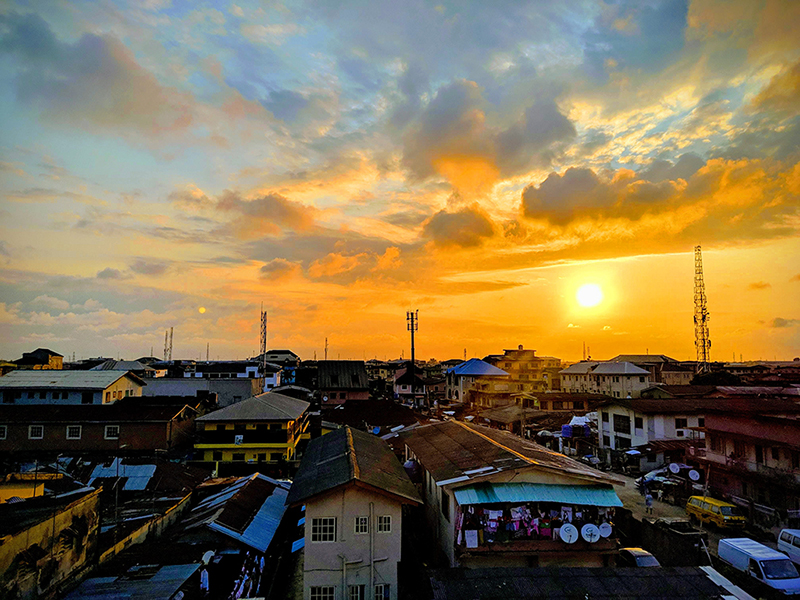
6.0 HOW TO LIFT 100 MILLION PEOPLE OUT OF POVERTY
It is clear that much needs to be done to help lift millions of Nigerians out of poverty. We recommend the following approaches and interventions:
The place to begin in any effort to lift 100 million Nigerians out of extreme poverty is in the political and elite space: it is essential that an elite consensus be framed, and a bargain struck, that taking 100 million Nigerians out of extreme poverty is the primary goal of politics and governance alongside the imperative of national security.
- This consensus, and the bargain that leads to it, is important because politicians and policy makers often tend to be influenced more by economic growth numbers, without a full appreciation of the reality (as we have seen in Nigeria), that a national economy can grow in GDP terms but without addressing poverty. In other words, it is possible for an economy to be growing while significant numbers of a population are getting poorer.
- The elite consensus approach, which is anchored more on political economy than simply on technical policy, accords with the reality that the factors that most affect Nigeria’s economy, including the prevalence of poverty, low productivity and systemic corruption, are mainly issues of political economy – the relationships between individuals, government and its institutions, and public policy.
- Whoever is elected President of Nigeria in the presidential elections scheduled for 2023 must begin the process of building this elite consensus. Such a consensus must necessarily involve sacrifices on the part of the elite. This may include giving up some self-seeking advantages in return for other opportunities, provided the focus shifts to creating opportunities and investments for wealth-creation for the urban and rural poor.
- Given that it will be difficult to achieve complete unanimity within the elite class – former heads of state and retired military generals, leading politicians across the political parties, the most influential traditional rulers and clergy, the Organized Private Sector, media proprietors, and civil society – specific individuals in each of these subsets of the most influential elite need to be engaged, persuaded to the consensus and the inherent bargains, and deployed to widen the “consensus net”.
- A fundamental aspect of this elite consensus must be clarity on the philosophical foundations for the huge effort that will drive the process of development transformation anchored on lifting 100 million extremely poor people out of poverty and into the middle class. To be consistent and robust, Nigeria’s policy choices must be anchored on an understanding of the roles of the state and the market, the balance between the two, which pathways to utilise – state-leaning or market-driven or the precise weights to attach to the two broad choices where combinations from each are to be deployed.
This requires a careful interrogation based both on evidence from other countries, and Nigeria’s unique circumstances. These circumstances include the reality of weak institutions and a lack of state capacity, suggesting that no matter what path the political or elite consensus will take, strengthening the capacity of the state and its institutions to a level of minimum credibility that is presently lacking is an urgent priority. To begin with, therefore, effective reform of the civil service addressing its size, capacity for service delivery and its remuneration is inevitable.
- The incoming Nigerian government after the elections in February 2023 should increase public spending on health and education, bolster productive jobs, and improve the effectiveness of social protection. The share of the education and health sectors in the federal governments and state governments’ budgets should ideally be not less than 20% for education and 15% for health.The incoming Nigerian government after the elections in February 2023 should increase public spending on health and education, bolster productive jobs, and improve the effectiveness of social protection. The share of the education and health sectors in the federal governments and state governments’ budgets should ideally be not less than 20% for education and 15% for health.
- These should be carefully targeted investments, not wasted on recurrent expenditures. For education, for example, targeting poverty effectively in a foundational manner requires investments in teacher training, curriculum reform, and learning methods that focus on training young people in skills (including technology) and creative thinking–as opposed to the prevalent rote learning approach of “cram and pour”–that are relevant to job markets in the 21st century. In healthcare, investments should target expanding effective and affordable primary healthcare in rural areas.
- Implementing pro-poor initiatives will require unlocking fiscal space; abolishing expensive subsidies for consumption (including petrol subsidies), alongside countervailing measures to protect the poor as reforms are effected. Regarding petrol subsidy, for example, abolishing the fiscal practice, which in Nigeria is based on questionable assumptions about petrol consumption levels and in 2022 received an allocation of N4 trillion, should be accompanied by investments in subsidised public transport systems in all Local Government Areas in all the 36 states and the Federal Capital Territory to cushion the impact of subsidy removal on the poor and to help check inflationary trends that could arise from increased transportation costs.
- This subsidized system, to be developed in a collaboration between the central and state governments, would require in reality only a small percentage of the fiscal resources presently spent on petrol subsidies by the Federal Government of Nigeria. The balance saved from further spending on the petrol subsidy, which in our estimate would not be less than N3.5 trillion per annum, would be better invested in social infrastructures such as education and healthcare, and targeted, transparently managed and effective social protection for poor citizens.
- Other structural reforms guided by evidence are urgently needed to foster and sustain pro-poor growth and raise Nigerians out of extreme poverty. These include macroeconomic reforms that include expanding the tax net for improved fiscal revenue generation but not raising taxes on businesses or consumers, introducing a wealth tax for Nigerians with very high levels of personal wealth, reduction of waivers to individual companies with the exception of tax-reductions-for-infrastructure construction deals, and the abolition of multiple taxations on small businesses.
- Other necessary reforms include exchange rate policy reform, in particular, ending multiple exchange rates that encourage arbitrage and corruption; policies to boost the productivity of farm and non-farm household enterprises; realistic electricity tariff rates in return for accountability of power generation and distribution companies for the provision of reliable electricity, investments in green energy sources, more effective provision of water, and sanitation (including incentives for businesses involved in providing such basic needs) and bolstering information and communication technologies, in particular broadband access.
- Conflict is spreading and intensifying across Nigeria; it is important to implement both peace-building measures and programmes to support poor and vulnerable Nigerians while also limiting the risk of exacerbating fragility and conflict. Conflict resolution, especially in the country’s northern states, would do much to reduce
or eradicate poverty. Data can provide vital guidance on how to design, monitor, and evaluate pro-poor projects and programmes, giving a voice to poor and vulnerable Nigerians. - Land reforms, including the abolition of the Land Use Act which vests ownership of land in the state, with individuals having to apply for a 99-year lease, are necessary to empower the poor with unlimited rights to ownership, use and disposal of land for purposes of wealth creation. The present land rights regime has promoted bureaucratic bottlenecks, corruption, and elite concentration in land ownership in Nigeria.
- Empowerment of (poor) women by assuring their access to productive assets and their participation in political decision-making. Gender-specific reforms, such as in the availability of microfinance at single-digit interest rates and improved rights to own land, are necessary to address the gender dimensions of poverty in Nigeria. The Federal Government of Nigeria needs to ensure urgent, robust, and visible-impact implementation of its National Gender Policy on Agriculture, launched in 2019.
- More broadly, access to capital is fundamental for wealth creation by the poor. The present lopsided focus on credit restricts opportunities for access to capital because of the high costs of capital that comes from high interest rates, weak infrastructure, and high levels of collateral requirements for bank loans. Development finance initiatives spearheaded by the Central Bank of Nigeria at single-digit interest rates often do not reach the poorest segments of the population, many of whom lack education.
- Moreover, micro-finance banks offer a potential to increase access to credit for the poor, but still lend at high interest rates. The CBN needs to invest more into this channel and introduce enough “pipeline capital” to ensure the poor can borrow at single digit interest rates, while the MFBs and the CBN itself still make a profit from a well-structured programme. The development finance programmes of the CBN should have a more narrow focus on poverty eradication.
- To overcome the constraints of an excessive reliance on credit, the government should invest in a public-private-partnership venture capital fund for tertiary education graduates and other Nigerians to start new ventures and create jobs. The ownership structure should be 51/49% between private sector investors the Federal Government of Nigeria and private sector investors.
- This fund should have a minimum of N1 trillion initially (ideally between N1-N3 trillion) in investable capital, and investments should be focused on micro and small businesses that require, on average, between N100,000 to N1 million to capitalize. The fund should be managed by the private sector for transparency and efficiency based on business principles including accountabilities for persons who receive venture funding, just as in credit.
- While a number of social protection programs already exist, and a newly enacted Start-Up Bill has recently been enacted, these are state-led approaches that have largely proved deficient in efficiency and impact, and have not seriously involved private sector wealth creation approaches. Experience has proved that there must be a limit to handouts that are prone to massive abuse – at the very least a balance between state-run poverty alleviation programs that may encourage dependency – and private sector-driven wealth creation approaches.
- Nigeria needs to establish a comprehensive, professionally designed social protection program that is backed by legislation and becomes a permanent feature of governance and combating poverty. This will prevent such programmes from becoming subject to the vagaries of an inconsistent attitude by different administrations from different political parties that may emerge through electoral cycles. A key plank of such a social protection system must be social security for citizens aged 65 and above. This cohort has a population of 5 million people.
- If leakages of public revenue such as crude oil theft (estimated to cost Nigeria $700 million per month or $8.4 billion per annum) could be plugged, alongside effective fiscal reforms and rational reductions in wasteful costs of governance, Nigeria can afford a stipend of N30000 per month for such citizens who have no pensions. This would result in a social security bill of, at most, N1.8 trillion per annum for 5 million senior citizens (and there are significant numbers of senior citizens who get pensions and may not be eligible for social security, which should be targeted at persons living in extreme poverty).
- Alongside other social protection programmes, the Federal Government of Nigeria should be able to invest N5-7 trillion annually in social protection. With investments of similar amounts in education and healthcare expansion, it is possible to begin to reverse extreme poverty in Nigeria. To further mobilise fiscal resources for such investments, in addition to petrol subsidy-removal, major infrastructure projects except rural infrastructure should be undertaken through public-private-partnerships.
- Other social protection programs should be focused on persons with disabilities, temporary unemployment support (not more than 12 months) for young people, conditional upon undergoing skill acquisition training, and conditional cash transfers for poor families linked to school enrolment for their children. Greater use should be made of data from the mobile telephone ownership across the country for more accurate targeting of these programmes. The programs must be regularly, independently and forensically audited to prevent corruption and abuse, and their impact assessed.
- Combating climate change (desertification, flooding and poverty-enhancing impacts on agriculture etc) is essential. This requires a proactive, preventive approach to flooding and desertification in particular.
- Other longer-term pro-poor policy priorities include using macroeconomic levers to speed Nigeria’s structural economic transformation and the creation of wage jobs; boosting productivity in farm and non-farm household enterprises, for example through investments in human capital and high-yield seedlings for agriculture; and investing in bedrock infrastructure for inclusive growth.
- A new approach to the setting of the minimum wage, currently at N30,000 a month, is required. The minimum wage needs to be more frequently reviewed and revised, in order to maintain a wage level that is closer to the reality of food and other prices. At the least, the minimum wage needs to be reviewed upward to match or surpass the current extreme poverty level of income of $2.15 a day. The impact of inflation in recent years calls for an upward review of the current minimum wage. The timing for such an upward review, however, must lag other recommended fiscal reforms and broader macroeconomic reforms that will put the government on a stronger fiscal footing. Nigeria’s ideal minimum wage should be no less than N50,000
- Lastly, given that poverty increases with the number of household members (or family size) in both male and female-headed households, there is an urgent need to intensify family planning services and related activities in Nigeria. This has to be carried out with material/cash incentives so as to improve knowledge, acceptance, and practice (KAP) of family planning. This will involve not only increased financial outlay but also research on fertility determinants as well as decentralised planning, delivery, and supervision of family planning services.
Moreover, micro-finance banks offer a potential to increase access to credit for the poor, but still lend at high interest rates. The CBN needs to invest more into this channel and introduce enough “pipeline capital” to ensure the poor can borrow at single digit interest rates, while the MFBs and the CBN itself still make a profit from a well-structured programme. The development finance programmes of the CBN should have a more narrow focus on poverty eradication.
To overcome the constraints of an excessive reliance on credit, the government should invest in a public-private-partnership venture capital fund for tertiary education graduates and other Nigerians to start new ventures and create jobs. The ownership structure should be 51/49% between private sector investors the Federal Government of Nigeria and private sector investors.
This fund should have a minimum of N1 trillion initially (ideally between N1-N3 trillion) in investable capital, and investments should be focused on micro and small businesses that require, on average, between N100,000 to N1 million to capitalize. The fund should be managed by the private sector for transparency and efficiency based on business principles including accountabilities for persons who receive venture funding, just as in credit.
While a number of social protection programs already exist, and a newly enacted Start-Up Bill has recently been enacted, these are state-led approaches that have largely proved deficient in efficiency and impact, and have not seriously involved private sector wealth creation approaches. Experience has proved that there must be a limit to handouts that are prone to massive abuse – at the very least a balance between state-run poverty alleviation programs that may encourage dependency – and private sector-driven wealth creation approaches.
Nigeria needs to establish a comprehensive, professionally designed social protection program that is backed by legislation and becomes a permanent feature of governance and combating poverty. This will prevent such programmes from becoming subject to the vagaries of an inconsistent attitude by different administrations from different political parties that may emerge through electoral cycles. A key plank of such a social protection system must be social security for citizens aged 65 and above. This cohort has a population of 5 million people.
If leakages of public revenue such as crude oil theft (estimated to cost Nigeria $700 million per month or $8.4 billion per annum) could be plugged, alongside effective fiscal reforms and rational reductions in wasteful costs of governance, Nigeria can afford a stipend of N30000 per month for such citizens who have no pensions. This would result in a social security bill of, at most, N1.8 trillion per annum for 5 million senior citizens (and there are significant numbers of senior citizens who get pensions and may not be eligible for social security, which should be targeted at persons living in extreme poverty).
Alongside other social protection programmes, the Federal Government of Nigeria should be able to invest N5-7 trillion annually in social protection. With investments of similar amounts in education and healthcare expansion, it is possible to begin to reverse extreme poverty in Nigeria. To further mobilise fiscal resources for such investments, in addition to petrol subsidy-removal, major infrastructure projects except rural infrastructure should be undertaken through public-private-partnerships.
Other social protection programs should be focused on persons with disabilities, temporary unemployment support (not more than 12 months) for young people, conditional upon undergoing skill acquisition training, and conditional cash transfers for poor families linked to school enrolment for their children. Greater use should be made of data from the mobile telephone ownership across the country for more accurate targeting of these programmes. The programs must be regularly, independently and forensically audited to prevent corruption and abuse, and their impact assessed.
Combating climate change (desertification, flooding and poverty-enhancing impacts on agriculture etc) is essential. This requires a proactive, preventive approach to flooding and desertification in particular.
Other longer-term pro-poor policy priorities include using macroeconomic levers to speed Nigeria’s structural economic transformation and the creation of wage jobs; boosting productivity in farm and non-farm household enterprises, for example through investments in human capital and high-yield seedlings for agriculture; and investing in bedrock infrastructure for inclusive growth.
A new approach to the setting of the minimum wage, currently at N30,000 a month, is required. The minimum wage needs to be more frequently reviewed and revised, in order to maintain a wage level that is closer to the reality of food and other prices. At the least, the minimum wage needs to be reviewed upward to match or surpass the current extreme poverty level of income of $2.15 a day. The impact of inflation in recent years calls for an upward review of the current minimum wage. The timing for such an upward review, however, must lag other recommended fiscal reforms and broader macroeconomic reforms that will put the government on a stronger fiscal footing. Nigeria’s ideal minimum wage should be no less than N50,000
Lastly, given that poverty increases with the number of household members (or family size) in both male and female-headed households, there is an urgent need to intensify family planning services and related activities in Nigeria. This has to be carried out with material/cash incentives so as to improve knowledge, acceptance, and practice (KAP) of family planning. This will involve not only increased financial outlay but also research on fertility determinants as well as decentralised planning, delivery, and supervision of family planning services.
Between 2003 and 2009, 21 million people reportedly escaped poverty in Brazil while an average of 19 million Chinese escaped the poverty trap every year for the past 40 years.

7.0 CHINA AND BRAZIL
Brazil and China, and to a lesser extent India – three countries that are members of the BRICS countries that also include Russia and South Africa, have provided important lessons for the world on how to beat extreme poverty. There are lessons Nigeria can learn from these efforts, their successes, and their limitations.
Brazil
A middle-income country with a population of 214 million people (similar to Nigeria’s 216 million people), a GDP of $1.6 trillion (four times the size of Nigeria’s) and a rising global power, Brazil has long been known as one of the most unequal countries in the world. The country is actively pursuing poverty reduction by implementing five main programmes:
Mundo Sem Pobreza (World Without Poverty): The well-known Bolsa Familia, a cash transfer programme, is one of the programmes of the World Without Poverty, a partnership of the International Policy Centre for Inclusive Growth, the Institute for Applied Economic Research, and the Brazilian Ministry of Social Development that was created in 2013. Under the Bolsa Familia, poor parents receive a monthly allowance in exchange for sending their children to school. The programme reduced poverty from 9.7% to 4.3% over a period of 10 years. This was also because of its broad scope and coverage – some 50 million low-income Brazilians, or a quarter of the total population.
Brasil Sem Miseria (Brazil Without Misery): This program, which began in
2011, supports Brazilian families earning a monthly income of less than $70 per person. Within four years, this programme took 22 million Brazilians out of extreme poverty.
National Program for Access to Technical Education and Employment: This programme enables young people acquire technical skills that give better access to employment opportunities. Alongside the programme, Brazil also provides free public education.
Programa de Combate a Pobreza Rural (Rural Poverty Reduction Program): This is a social protection programme targeted at communal levels in rural communities, in particular in the impoverished Northeast region of Brazil. The programme includes provisions for the involvement of the poor citizens in local governance processes, giving them a voice and a stake, and addressing issues of multidimensional poverty.
Fome Zero Programme (Zero Hunger Program): Financial support to farmers, combined with a school feeding programme. The program reduced malnutrition rates from 12.7% to 3.5%, and markedly reduced infant mortality rates.
Between 2003 and 2009, 21 million people reportedly escaped poverty in the South American country. According to Brazil’s National Institute of Applied Economics Research (IPEA), the poverty incidence rate declined from 35.8 to 21.4 percent. Brazil, however, has experienced a reversal in its poverty reduction in recent years. After a period between 2003 and 2014 in which poverty was reduced from 41% to 17%, the poverty rate increased sharply from 20% in 2019 to 28% in 2021. This is partly as a result of the impact of the Covid-19 pandemic, as Brazil had the second highest numbers of casualties in the world after the United States, with 33 million infections and nearly 700,000 deaths from the pandemic.

China
Between 1978 and 2019, the poverty count in China dropped from 770 million people to 5.5 million people. China took 765 million of its citizens out of extreme poverty over the past four decades, meaning that an average of 19 million Chinese escaped the poverty trap every year for the past 40 years. In 2021 China announced that it had wiped out extreme poverty based on its national poverty threshold, and that it had achieved a “moderately prosperous society in all respects”. How was China able to accomplish this seeming miracle?
China’s poverty reduction policies can roughly be classified into four phases since 1978. These include the rural reform of 1978-1985, the National Targeted Poverty Reduction Programs of 1986-1993, the 8-7 Plan of 1994-2000, and the New Century Rural Poverty Alleviation Plan for 2001-2010. The 8-7 Plan mainly included three types of poverty programs: subsidised loans program, food-for-work program and government budgetary poor area development fund grants.
The momentous poverty eradication feat achieved by China has been anchored on six main factors. First, China’s success is an economic growth story, but, importantly, one accompanied by a structural transformation of its economy from an agrarian one to an industrial-productive one. This is an important difference from the economic growth experienced by Nigeria and many other African countries. Reforms began in the agricultural sector. Poor Chinese citizens benefited directly from investments in agricultural productivity that were accompanied by the introduction of market incentives. Reforms were incremental and, importantly, decentralised even in a country that is a centralised administrative state.
Second, Chinese government policies to eradicate poverty were first targeted at disadvantaged areas with little economic opportunities, and then later spread to poor households regardless of location. These policies focused on creating economic opportunities as a way to escape the poverty trap, rather than mere dependency. Social protection programmes for poor households were therefore only a part of the policy mix.
Third, effective governance helped develop and implement policy reduction policies, and there was strong monitoring and accountability.
Fourth, the high levels of human capital already achieved prior to 1978, through massive investments in education and healthcare expansion since the 1950s, played an important role in the success of the Chinese poverty eradication reforms. Relatively high levels of literacy enabled even poor Chinese to take advantage of opportunities offered by the reforms, although China still had a low GDP per capita of $156 in 1978 – lower than Nigeria’s GDP per capita of $527 in the same year.
Fifth, land reforms that removed state and commune ownership of agricultural land and increased individual and household ownership of such lands were a major driver of increased productivity and the success of China’s poverty reduction and consequent wealth creation. This aspect of the reforms was not incremental, but rather was executed as “shock therapy”, with ownership rights transferred to 700 million households between 1977 and 1979. This process was known as “decollectivisation”.
Sixth, and finally, the most important element in the achievement of the Chinese economic miracle was the visionary, bold and transformative political leadership of Deng Xiaoping following the death of Mao Zedong in 1976, combined with the strong capacity and administrative strength of Chinese state institutions. This was critical to China’s shift away from a socialist economy to a market-based one backed up by a strong, pro-developmental state – a system that came to be described as “state capitalism”.
Deng possessed ideological and philosophical clarity. This strength was amplified by the pragmatism of his thinking. He believed that the Chinese economy needed to embrace market-based incentives for China’s farmers, agricultural workers and industries, but believed the Chinese Communist Party and the state authorities needed to provide a strong guiding hand at the wheels of emerging capitalism. “It doesn’t matter whether the cat is black or white”, he said. “What matters is that it catches mice”.
Other important aspects of the Chinese reforms that defeated extreme poverty included strict population control, without which the country could not have achieved economic transformation, an approach of experimentation, learning and adapting lessons learned, a selective borrowing of foreign ideas and adaptation to an overarching Chinese template, and a focus on low hanging fruit first, and more difficult reforms later.
The path to [Nigeria's] poverty eradication runs firmly through a revitalization of rural economies; this will help reduce a drift to urban centres, where poverty accumulates in urban slums.
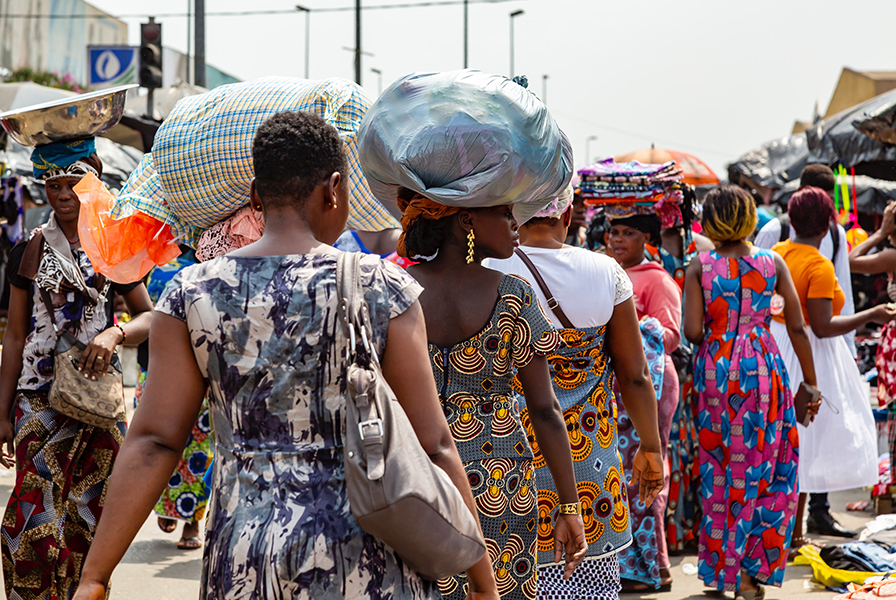
Lessons for Nigeria
There are several important lessons for Nigeria from the successes achieved in eradicating poverty in Brazil and China. They include:
- Create or make use of market opportunities as much as possible.
- Universalise secondary school education.
- Start from the agricultural sector, which provides 35% of total employment in Nigeria and is 30% of the country’s GDP – develop agricultural value chains such as farming, transportation, storage, processing and export of agricultural products and incentivize investment and employment in these value chains, and then shift to low-skilled, labour intensive industries to absorb a gradual shift from agriculture as part of economic diversification and structural transformation.
- The reform of land tenure is essential, and played a critical role in poverty eradication that began in the agricultural sector, similarly a mainstay of the Nigerian economy.
- Civil service reforms are necessary to ensure improved state capacity to provide administrative services, manage social protection effectively, and drive public policy for economic and societal transformation more broadly.
- The path to poverty eradication runs firmly through a revitalization of rural economies; this will help reduce a drift to urban centres, where poverty accumulates in urban slums. Land reforms will also support rural poverty eradication and create incentives for youth to stay behind and build productive lives.
- Political leadership in the building of an elite consensus on development is critical to real success in poverty eradication and creating a prosperous society.
- The political-structural decentralization of Nigeria through constitutional reforms that devolve more powers and responsibilities to state and local levels of governance will facilitate a marked reduction of poverty, in particular multidimensional poverty, in Nigeria.
8.0 CONCLUSION
Poverty and conflict have combined to make Nigeria a fragile state. While the Federal Government of Nigeria has made significant efforts to reduce poverty in Nigeria, the evidence of current poverty numbers and trends suggests that the scale of the problem far outstrips the government’s capacity at this time to defeat the scourge of poverty. To put it another way, Nigeria has become increasingly synonymous with poverty.
A full-scale war must be waged against poverty – and won – if the country is to have any real future. This requires a political elite consensus across partisan divides. This challenge must now become, along with insecurity, the central issue in the economic and social challenges confronting the Nigerian State.
Nigeria’s political leaders must also consider their own enlightened self-interest as a class: increasing levels of poverty will lead to a further breakdown of security and, inevitably, to social unrest. When the Chinese political elite under the leadership of Deng Xiaoping began the process of building an elite consensus on economic reforms and the eradication of poverty, they were also motivated by the need for the Chinese Communist Party to continue to maintain political control of the country. They realised that the rate of extreme poverty in China in the mid-1970s, when China’s GDP per capita was much lower than Nigeria’s, posed a strategic threat not just to the country, but to their positions and hold on power.
Without a focus, a consensus, and a comprehensive plan and effective system to combat poverty, a fixation on achieving economic growth without vastly increased levels of human capital, would be a missed opportunity. Such a plan must combine market approaches and stronger social protection, with an accent on effective targeting, expanding coverage, and measuring performance.
ABOUT THE AUTHORS
Kingsley Moghalu is the Founder and President of the Institute for Governance and Economic Transformation. He served as Deputy Governor of the Central Bank of Nigeria from 2009 to 2014, and subsequently as Professor of Practice in International Business and Public Policy at The Fletcher School of Law and Diplomacy at Tufts University. He previously worked in the United Nations System for 17 years in political, legal and external affairs and senior executive management roles at duty stations in Cambodia, New York (UN Headquarters), Croatia, Tanzania/Rwanda, and Switzerland.
Kingsley obtained his Doctor of Philosophy degree at the London School of Economics (LSE), a Master’s at The Fletcher School at Tufts University, and the LL.B. degree at the University of Nigeria, Nsukka, and received executive education at Harvard Kennedy School of Government, Harvard Business School, The Wharton School at the University of Pennsylvania, and the International Monetary Fund (IMF) Institute. He is the author of four books including Emerging Africa: How the Global Economy’s ‘Last Frontier’ Can Prosper and Matter (Penguin Books, 2014)
Damian Ude is a Research Fellow at the Institute for Governance and Economic Transformation. Prior to his appointment at IGET he was a Lecturer in Economics at Michael Okpara University of Agriculture in Umudike, Abia State, Nigeria., where he taught and supervised students in Research Methods, Advanced Macroeconomics, Advanced Microeconomics, Econometrics, and Energy Economics. Damian has published in books and journals on such topics as the youth unemployment challenge and rural transformation in Africa, industrialization processes, knowledge economy and competitiveness, infrastructural development and value addition in agricultural output in Nigeria, energy storage and market implications for powering African countries, and small and medium enterprises.
He obtained Ph.D., M.Sc. and B.Sc. degrees in Economics from the University of Nigeria, Nsukka, and is a member of the United States Econometric Society, Nigerian Economic Society, Nigerian Association of Energy Economics, and the Nigerian Institute of Management.
